Welcome to the Nanopore Community
Order MinION devices and consumables
Visit vwr.comNanopore-only Microbial Isolate Sequencing Solution (NO-MISS) - Rapid Barcoding Kit V14 (SQK-RBK114.24 or SQK-RBK114.96)
Version for device: MinION
Introduction to the protocol
Overview of the protocol
Overview of the protocol
-
Introduction to the Nanopore-only Microbial Isolate Sequencing Solution (NO-MISS) protocol
This end to end protocol describes our Nanopore-Only Microbial Isolate Sequencing Solution (NO-MISS): a flexible approach allowing sequencing of 4 to 24 microbial isolate genomes per MinION Flow Cell, generating a minimum coverage of 50x per genome.
The 50X coverage threshold is sufficient for downstream analyses including: accurate assembly and plasmid resolution, AMR profiling, core genome (cg) and whole genome (wg) multi-locus sequence typing (MLST), and cg/wgSNP typing. You can analyse your sequencing data using EPI2ME, which provides a user-friendly bioinformatics workflow.
We provide multiple DNA extraction approaches, depending on requirements, and starting organism (bacteria, fungi/yeast). These are key in achieving reliable flow cell output and genome coverage. The sample specific extraction methods use NEB Monarch® Spin gDNA Extraction Kit, while the universal method uses a bead-beating method and the Maxwell® RCS PureFood Pathogen Kit.
The extracted gDNA is then tagmented and sequenced using our Rapid Barcoding Kit (SQK-RBK114.24 or SQK-RBK114.96). Up to 24 samples per sequencing experiment for bacterial isolates (up to 7 Mb genomes) and up to 8 samples for fungi/yeast isolates can be processed to achieve the 50x coverage threshold. Use a minimum of four barcodes per run to maintain performance.
Detailed instructions for setting up the sequencing run on MinKNOW and downstream analysis are also included for a complete end-to-end protocol. We recommend sequencing up to 72 hours and generating at least 50x coverage per sample (approx. 0.5 Gb per barcode, assuming 5 Mb genome).We recommend updating MinKNOW to the latest version prior to starting a sequencing run. The basecalling model v4.3 found in Dorado 0.5.0 onwards provides improved accuracy for bacterial DNA and is included in MinKNOW release v24.02 or newer.
For more information on updating MinKNOW, please refer to our MinKNOW protocol.
End-to-end workflow overview

Steps in the sequencing workflow:
Prepare for your experiment
You will need to:
- Extract your DNA, and check quantity and purity. The quality checks performed during the protocol are essential in ensuring experimental success.
- Ensure you have your sequencing kit, the correct equipment and third-party reagents.
- Download the software for acquiring and analysing your data.
- Check your flow cell to ensure it has enough pores for a good sequencing run.
Sample preparation
Using the relevant gDNA extraction method, you will need to lyse your cells, extract your gDNA, and quantify the DNA:
- Universal bead-beating method:
- Universal bead-beating gDNA extraction:
- For high throughput requirements and universal applications.
- Manual column-based methods:
- Bacteria gDNA extraction:
- For bacteria, such as Escherichia coli, Klebsiella pneumoniae, Pseudomonas aeruginosa, Serratia marcescens, Enterococcus faecalis, and Bacillus subtilis or staphylococci such as Staphylococcus aureus, and Staphylococcus epidermidis.
- Hard to lyse organisms gDNA extraction:
- For bacteria, such as Mycobacterium tuberculosis.
- Fungi gDNA extraction:
- For fungi/yeast, such as Candida albicans, Candida tropicalis, and Candida parapsilosis.
Library preparation
The table below is an overview of the steps required in the library preparation, including timings and stopping points.
Library preparation step Process Time Stop option DNA barcoding Tagmentation of the DNA using the Rapid Barcoding Kit V14 15 minutes 4°C overnight Sample pooling and clean-up Pooling of barcoded libraries and AMPure XP Bead clean-up 25 minutes 4°C overnight Adapter ligation Attach the sequencing adapters to the DNA ends 5 minutes We strongly recommend sequencing your library as soon as it is adapted Priming and loading the flow cell Prime the flow cell and load the prepared library for sequencing 5 minutes Sequencing and analysis
You will need to:- Start a sequencing run using the MinKNOW software, which will collect raw data to basecall and demultiplex the barcoded reads.
- Perform downstream analysis uing the isolate mode of the wf-bacterial-genomes workflow in EPI2ME.
Equipment and consumables
- Materials
-
- 200 ng of extracted gDNA per sample
- Rapid Barcoding Kit 24 V14 (SQK-RBK114.24) OR Rapid Barcoding Kit 96 V14 (SQK-RBK114.96)
- Consumables
-
- MinION and GridION Flow Cell
- Monarch® Spin gDNA Extraction Kit (NEB, T3010S/L)
- Qubit 1x dsDNA HS Assay Kit (ThermoFisher, Q33230)
- Qubit 1x dsDNA BR Assay Kit (ThermoFisher, cat # Q33265)
- PowerBead Pro tube (Qiagen, 19301)
- BashingBead Buffer (Zymo, D6001-3-40)
- Phosphate-buffered saline (PBS), pH 7.4 (Thermo Fisher, 10010023)
- TE buffer (Sigma, 8890-100ML)
- 5 M sodium chloride solution (Sigma, S6546)
- CTAB buffer (Promega, MC1411)
- (Optional) Extra reagents for custom CTAB buffer:
- CTAB (Sigma, H6269)
- 0.5 M EDTA (Fisher Scientific, 11568896)
- Trizma® hydrochloride solution (Sigma, T2819)
- Extra reagents for bacteria gDNA extraction:
- Lysozyme human (Sigma, L1667)
- Sodium dodecyl sulfate (SDS) at 10% v/v (Sigma, 71736)
- Trizma® hydrochloride solution (Sigma, T2819)
- Achromopeptidase (Sigma, A3547)
- Extra reagents and consumables for hard to lyse organisms gDNA extraction:
- Lysozyme human (Sigma, L1667)
- Empty FastPrep® 2mL Lysing Matrix tubes (MP Biomedicals, 115076200)
- Screw Cap for 2 mL Lysing Matrix tubes (MP Biomedicals, 115067005)
- Glass beads, 4 mm (MP Biomedicals, 116914801)
- Extra reagents for fungi gDNA extraction:
- MetaPolyzyme (Sigma, MAC4L-5MG)
- Agencourt AMPure XP beads (Beckman Coulter, A63881)
- Extra reagents for automated bead-beating gDNA extraction:
- RNase A (QIAGEN, 19101)
- Proteinase K (QIAGEN, 19131)
- Maxwell® RSC PureFood Pathogen kit (Promega, AS1660)
- Bovine Serum Albumin (BSA) (50 mg/ml) (e.g Invitrogen™ UltraPure™ BSA 50 mg/ml, AM2616)
- Freshly prepared 80% ethanol in nuclease-free water
- Nuclease-free water (e.g. ThermoFisher, AM9937)
- PCR plate seals
- 96-well PCR plate, semi-skirted (e.g. Starlab, I1402-9800)
- 1.5 ml Eppendorf DNA LoBind tubes
- 2 ml Eppendorf DNA LoBind tubes
- 0.2 ml thin-walled PCR tubes or 0.2 ml 96-well PCR plate
- Qubit™ Assay Tubes (Invitrogen, Q32856)
- Equipment
-
- MinION or GridION device
- MinION and GridION Flow Cell Light Shield
- Vortex Adapter (Qiagen 13000-V1-24)
- Vortex mixer
- Thermal cycler
- Timer
- Thermomixer
- Magnetic rack
- Microplate centrifuge, e.g. Fisherbrand™ Mini Plate Spinner Centrifuge (Fisher Scientific, 11766427)
- Eppendorf 5424 centrifuge (or equivalent)
- Qubit fluorometer (or equivalent for QC check)
- Multichannel pipette and tips
- P1000 pipette and tips
- P200 pipette and tips
- P100 pipette and tips
- P20 pipette and tips
- P2 pipette and tips
- Ice bucket with ice
- Extra equipment for automated bead-beating gDNA extraction:
- Maxwell® RSC Instrument (MPBiomedicals, AS4500)
- Optional Equipment
-
- Hula mixer (gentle rotator mixer)
-
For this protocol, the following inputs are required per sample:
Input requirements per sample for the extraction methods:
Universal bead-beating gDNA extraction: 1 ml liquid overnight culture (~1 x 108 – 109 cfu/ml) or half of a loop of colonies from a plate
Bacteria gDNA extraction: 200 µl liquid overnight culture (~1 x 108 – 109 cfu/ml) or 1/8 of a loop of colonies from a plate
Hard to lyse organisms gDNA extraction: 5 – 10 mg cells from solid or liquid media
Fungi gDNA extraction: 2 ml of ~1 x 107 cfu/ml overnight culture or a full 10 µl inoculating loop from a plate
For library preparation, 200 ng in 10 µl of extracted gDNA per sample is required.
-
Third-party reagents
Depending on the extraction protocol used, not all third-party reagents are required.
We have validated and recommend the use of all the third-party reagents used in this protocol. Alternatives have not been tested by Oxford Nanopore Technologies.
For all third-party reagents, we recommend following the manufacturer's instructions to prepare the reagents for use.
-
Custom CTAB buffer
Custom CTAB buffer can be prepared instead of purchasing. Below are the reagents and concentrations required, with suggested examples with excess.
Reagent Stock Final concentration Volume for 12 samples Volume for 24 samples CTAB - 2% v/v 60 µl 120 µl EDTA 0.5 M 40 mM 240 µl 480 µl Sodium chloride 5 M 1.4 M 833 µl 1,666 µl Trizma hydrochloride solution, pH 8 1 M 100 mM 300 µl 600 µl Nuclease-free water - - 1567 µl 3,134 µl Total - - 3,000 µl 6,000 µl -
For staphylococcal inputs
Staphylococcal Lysis Buffer (SLB) is required for the bacterial gDNA extraction method for staphylococcal inputs.
Reagent Stock Final concentration Volume for 12 samples with excess Volume for 24 samples with excess Trizma hydrochloride solution, pH 9 1 M 100 mM 150 ul 300 µl Sodium chloride 5 M 10 mM 3 ul 6 µl SDS 10% v/v 0.1% v/v 15 ul 30 µl Nuclease-free water - - 1332 ul 2664 µl Total volume - - 1,500 ul 3,000 µl The SDS in the Staphylococcal Lysis Buffer (SLB) is essential for preventing the degradation of staphylococci DNA. Exclusion of SDS from the buffer results in a larger smear of DNA when run on a gel.
-
Input DNA
How to QC your input DNA
It is important that the input DNA meets the quantity and quality requirements. Using too little or too much DNA, or DNA of poor quality (e.g. highly fragmented or containing RNA or chemical contaminants) can affect your library preparation.
For instructions on how to perform quality control of your DNA sample, please read the Input DNA/RNA QC protocol.
Chemical contaminants
Depending on how the DNA is extracted from the raw sample, certain chemical contaminants may remain in the purified DNA, which can affect library preparation efficiency and sequencing quality. Read more about contaminants on the Contaminants page of the Community.
-
Check your flow cell
We highly recommend that you check the number of pores in your flow cell prior to starting a sequencing experiment. This should be done within 12 weeks of purchasing for MinION/GridION/PromethION or within four weeks of purchasing Flongle Flow Cells. Oxford Nanopore Technologies will replace any flow cell with fewer than the number of pores in the table below, when the result is reported within two days of performing the flow cell check, and when the storage recommendations have been followed. To do the flow cell check, please follow the instructions in the Flow Cell Check document.
Flow cell Minimum number of active pores covered by warranty Flongle Flow Cell 50 MinION/GridION Flow Cell 800 PromethION Flow Cell 5000 -
Rapid Barcoding Kit 24 V14 (SQK-RBK114.24) contents
We are in the process of reformatting the barcodes provided in this kit into a plate format. This will reduce plastic waste and facilitates automated applications.
Plate format
Name Acronym Cap colour No. of vials Fill volume per vial (µl) Rapid Adapter RA Green 1 15 Adapter Buffer ADB Clear 1 100 AMPure XP Beads AXP Amber 2 1200 Elution Buffer EB Black 1 500 Sequencing Buffer SB Red 1 700 Library Beads LIB Pink 1 600 Library Solution LIS White cap, pink label 1 600 Flow Cell Flush FCF Clear cap, light blue label 1 8000 Flow Cell Tether FCT Purple 1 200 Rapid Barcode plate RB01-24 - 2 plates, 3 sets of barcodes per plate 5 µl per well This Product Contains AMPure XP Reagent Manufactured by Beckman Coulter, Inc. and can be stored at -20°C with the kit without detriment to reagent stability.
Vial format
Name Acronym Cap colour No. of vials Fill volume per vial (µl) Rapid Adapter RA Green 1 15 Adapter Buffer ADB Clear 1 100 AMPure XP Beads AXP Amber 2 1,200 Elution Buffer EB Black 1 500 Sequencing Buffer SB Red 1 700 Library Beads LIB Pink 1 600 Library Solution LIS White cap, pink label 1 600 Flow Cell Flush FCF Blue 6 1,170 Flow Cell Tether FCT Purple 1 200 Rapid Barcodes RB01-24 Clear 24 15 This Product Contains AMPure XP Reagent Manufactured by Beckman Coulter, Inc. and can be stored at -20°C with the kit without detriment to reagent stability.
-
Rapid Barcoding Kit 96 V14 (SQK-RBK114.96) contents
Name Acronym Cap colour No. of vials Fill volume per vial (µl) Rapid Adapter RA Green 2 15 Adapter Buffer ADB Clear 1 100 AMPure XP Beads AXP Amber 3 1,200 Elution Buffer EB Black 1 1,500 Sequencing Buffer SB Red 1 1,700 Library Beads LIB Pink 1 1,800 Library Solution LIS White cap, pink label 1 1,800 Flow Cell Flush FCF Clear 1 15,500 Flow Cell Tether FCT Purple 2 200 Rapid Barcodes RB01-96 - 3 plates 8 µl per well This Product Contains AMPure XP Reagent Manufactured by Beckman Coulter, Inc. and can be stored at -20°C with the kit without detriment to reagent stability.
Sample preparation
Sample extraction method selection
Sample extraction method selection
-
Optimised extraction method decision
We have developed four optimised extraction methods to generate high quality genomic DNA from your cell cultures, allowing maximised sequencing output using this method.
What extraction method is right for me?
Sample extraction method Sample type Sample Input Expected yield Expected DNA Integrity Number (DIN) Average sequencing read lengths Extraction kits used Universal bead-beating gDNA extraction Universal applications: bacteria, fungi or yeast 1 ml liquid overnight culture (~1 x 108 – 109 cfu/ml) or half of a loop of colonies from a plate >200 ng/µl per sample 7-9 ~4-7 kb QIAGEN PowerBead Tube and Promega Maxwell® RSC PureFood Pathogen kit Bacteria gDNA extraction Bacterial 200 µl liquid overnight culture (~1 x 108 – 109 cfu/ml) or 1/8 of a loop of colonies from a plate ~15-20 ng/µl per sample 9 >7 kb - Size will vary based on sample input species NEB Monarch Spin gDNA Extraction Kit Hard to lyse organisms gDNA extraction Mycobacterium tuberculosis
(or hard to extract bacterial samples)5 – 10 mg cells from solid or liquid media ~15-40 ng/µl per sample 8 >7 kb - Size will vary based on sample input species NEB Monarch Spin gDNA Extraction Kit Fungi gDNA extraction Fungi or yeast 2 ml of ~1 x 107 cfu/ml overnight culture or a full 10 µl inoculating loop from a plate ~40 ng/µl per sample N/A >7 kb - Size will vary based on sample input species NEB Monarch Spin gDNA Extraction Kit Note: The yield, DIN and sequencing read length of extracted DNA may vary depending on sample quality and species. Please ensure you are following the correct method and using high-quality sample inputs.
Follow the links in the table above for the extraction methods documentation.
Alternatively, these extraction methods can be found in the Extraction Protocols tab in the Documentation space on the Nanopore Community
Library preparation
Library preparation
- Materials
-
- 200 ng of extracted gDNA per sample
- Rapid Barcodes (RB01-24 or RB01-96)
- Rapid Adapter (RA)
- Adapter Buffer (ADB)
- AMPure XP Beads (AXP)
- Elution Buffer (EB)
- Consumables
-
- Qubit dsDNA HS Assay Kit (Invitrogen, Q32851)
- Nuclease-free water (e.g. ThermoFisher, AM9937)
- Freshly prepared 80% ethanol in nuclease-free water
- Eppendorf twin.tec® PCR plate 96 LoBind, semi-skirted (Eppendorf™, cat # 0030129504) with heat seals
- 0.2 ml thin-walled PCR tubes
- 1.5 ml Eppendorf DNA LoBind tubes
- 2 ml Eppendorf DNA LoBind tubes
- Qubit™ Assay Tubes (Invitrogen, Q32856)
- Equipment
-
- Ice bucket with ice
- Timer
- Thermal cycler
- Microplate centrifuge, e.g. Fisherbrand™ Mini Plate Spinner Centrifuge (Fisher Scientific, 11766427)
- Magnetic rack
- Hula mixer (gentle rotator mixer)
- Qubit fluorometer (or equivalent for QC check)
- P1000 pipette and tips
- P200 pipette and tips
- P100 pipette and tips
- P20 pipette and tips
- P10 pipette and tips
- P2 pipette and tips
- Multichannel pipette and tips
-
Sample throughput and Rapid Barcode use requirements with NO-MISS
This method has been developed to process 24 samples with a genome size of up to 7 Mb simultaneously.
For samples with a larger genome size ( >7 Mb), we recommend lowering the number of samples to be barcoded and sequenced simultaneously to 8 samples.
For optimal output, we currently do not recommend using fewer than 4 barcodes.
Note: This method provides a standardised process for sample throughput that we have validated in-house. These settings will be applicable to the majority of use-cases and we recommend all new users to follow the recommended method. Experienced users can adjust sample throughput (4 to 48 barcoded samples) based on sample quality, genome size, and coverage requirements.
-
Check your flow cell.
We recommend performing a flow cell check before starting your library prep to ensure you have a flow cell with enough pores for a good sequencing run.
See the flow cell check instructions in the MinKNOW protocol for more information.
-
Program the thermal cycler: 30°C for 2 minutes, then 80°C for 2 minutes.
-
Thaw kit components at room temperature, spin down briefly using a microfuge and mix by pipetting as indicated by the table below:
Reagent 1. Thaw at room temperature 2. Briefly spin down 3. Mix well by pipetting Rapid Barcodes (RB01-24 or RB01-96)) Not frozen ✓ ✓ Rapid Adapter (RA) Not frozen ✓ ✓ AMPure XP Beads (AXP) ✓ ✓ Mix by pipetting or vortexing immediately before use Elution Buffer (EB) ✓ ✓ ✓ Adapter Buffer (ADB) ✓ ✓ Mix by vortexing -
Prepare the DNA in nuclease-free water.
- Transfer 200 ng of genomic DNA per sample into 0.2 ml thin-walled PCR tubes or an Eppendorf twin.tec® PCR plate 96 LoBind.
- Adjust the volume of each sample to 10 μl with nuclease-free water.
- Pipette mix the tubes thoroughly and spin down briefly in a microfuge.
-
Select a unique barcode for every sample to be run together on the same flow cell.
Note: Use one barcode per sample.
-
In the 0.2 ml thin-walled PCR tubes or an Eppendorf twin.tec® PCR plate 96 LoBind, mix the following:
Reagent Volume per sample Template DNA (200 ng from previous step) 10 μl Rapid Barcodes (RB01-24 or RB01-96, one for each sample) 1.5 μl Total 11.5 μl -
Ensure the components are thoroughly mixed by pipetting and spin down briefly.
-
Incubate the tubes or plate at 30°C for 2 minutes and then at 80°C for 2 minutes. Briefly put the tubes or plate on ice to cool.
-
Spin down the tubes or plate to collect the liquid at the bottom.
-
Pool all barcoded samples in a clean 2 ml Eppendorf DNA LoBind tube, noting the total volume.
. Volume per sample For 24 samples Total volume 11.5 µl 276 µl -
Resuspend the AMPure XP Beads (AXP) by vortexing.
-
Add an equal volume of resuspended AMPure XP Beads (AXP) to the entire pooled barcoded sample, and mix by flicking the tube.
. Volume per sample For 24 samples Volume of AMPure XP Beads (AXP) added 11.5 µl 276 µl -
Incubate on a Hula mixer (rotator mixer) for 10 minutes at room temperature.
-
Prepare at least 2 ml of fresh 80% ethanol in nuclease-free water.
-
Spin down the sample and pellet on a magnet. Keep the tube on the magnet, and pipette off the supernatant.
-
Keep the tube on the magnet and wash the beads with 1 ml of freshly prepared 80% ethanol without disturbing the pellet. Remove the ethanol using a pipette and discard.
-
Repeat the previous step.
-
Briefly spin down and place the tube back on the magnet. Pipette off any residual ethanol. Allow to dry for 30 seconds, but do not dry the pellet to the point of cracking.
-
Remove the tube from the magnetic rack and resuspend the pellet by pipetting in 15 µl Elution Buffer (EB). Incubate for 10 minutes at room temperature.
-
Pellet the beads on a magnet until the eluate is clear and colourless, for at least 1 minute.
-
Remove and retain the full volume of eluate into a clean 1.5 ml Eppendorf DNA LoBind tube.
- Remove and retain the eluate which contains the DNA library in a clean 1.5 ml Eppendorf DNA LoBind tube
- Dispose of the pelleted beads
-
Optional ActionQuantify 1 µl of eluted sample using a Qubit fluorometer and Qubit dsDNA BR assay.
Expect ~150 ng/µl for 24 samples, assuming 70% of DNA was retained during the wash.
-
Transfer 11 µl of the sample into a clean 1.5 ml Eppendorf DNA LoBind tube.
-
In a fresh 1.5 ml Eppendorf DNA LoBind tube, dilute the Rapid Adapter (RA) as follows and pipette mix:
Reagent Volume Rapid Adapter (RA) 1.5 μl Adapter Buffer (ADB) 3.5 μl Total 5 μl -
Add 1 µl of the diluted Rapid Adapter (RA) to the barcoded DNA.
-
Mix gently by flicking the tube, and spin down.
-
Incubate the reaction for 5 minutes at room temperature.
Tip: While this incubation step is taking place you can proceed to the Flow Cell priming and loading section of the protocol.
Priming and loading the MinION and GridION Flow Cell
Priming and loading the MinION and GridION Flow Cell
- Materials
-
- Flow Cell Flush (FCF)
- Flow Cell Tether (FCT)
- Library Beads (LIB)
- Sequencing Buffer (SB)
- Consumables
-
- MinION and GridION Flow Cell
- Bovine Serum Albumin (BSA) (50 mg/ml) (e.g Invitrogen™ UltraPure™ BSA 50 mg/ml, AM2616)
- 1.5 ml Eppendorf DNA LoBind tubes
- Equipment
-
- MinION or GridION device
- MinION and GridION Flow Cell Light Shield
- P1000 pipette and tips
- P100 pipette and tips
- P20 pipette and tips
- P10 pipette and tips
-
Thaw the Sequencing Buffer (SB), Library Beads (LIB) or Library Solution (LIS, if using), Flow Cell Tether (FCT) and Flow Cell Flush (FCF) at room temperature before mixing by vortexing. Then spin down and store on ice.
-
To prepare the flow cell priming mix with BSA, combine the following reagents in a fresh 1.5 ml Eppendorf DNA LoBind tube. Mix by inverting the tube and pipette mix at room temperature:
Reagents Volume per flow cell Flow Cell Flush (FCF) 1,170 µl Bovine Serum Albumin (BSA) at 50 mg/ml 5 µl Flow Cell Tether (FCT) 30 µl Final total volume in tube 1,205 µl -
Open the MinION or GridION device lid and slide the flow cell under the clip. Press down firmly on the priming port cover to ensure correct thermal and electrical contact.
-
Optional ActionComplete a flow cell check to assess the number of pores available before loading the library.
This step can be omitted if the flow cell has been checked previously.
See the flow cell check instructions in the MinKNOW protocol for more information.
-
Slide the flow cell priming port cover clockwise to open the priming port.
-
After opening the priming port, check for a small air bubble under the cover. Draw back a small volume to remove any bubbles:
- Set a P1000 pipette to 200 µl
- Insert the tip into the priming port
- Turn the wheel until the dial shows 220-230 µl, to draw back 20-30 µl, or until you can see a small volume of buffer entering the pipette tip
Note: Visually check that there is continuous buffer from the priming port across the sensor array.
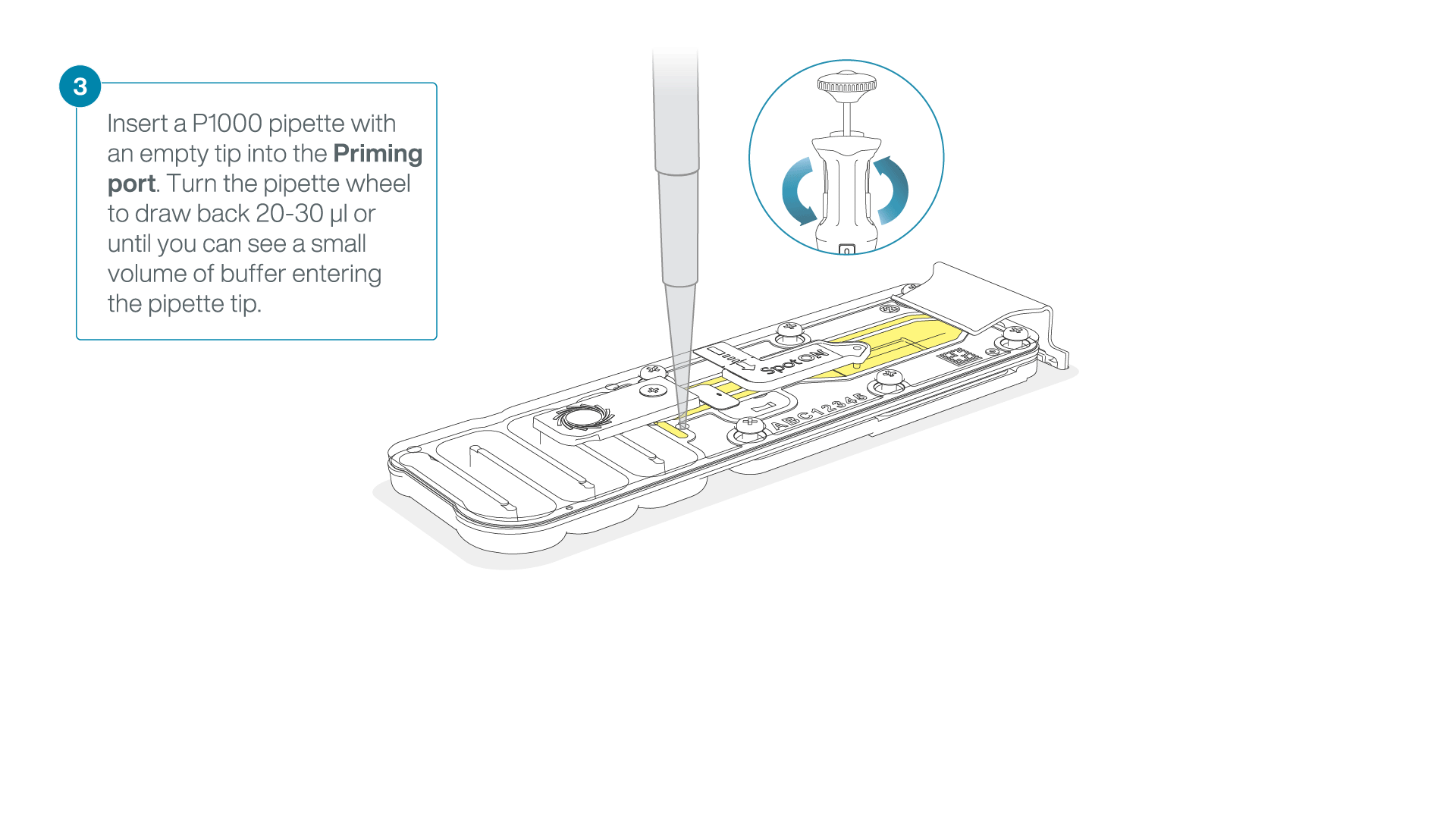
-
Load 800 µl of the priming mix into the flow cell via the priming port, avoiding the introduction of air bubbles. Wait for five minutes. During this time, prepare the library for loading by following the steps below.
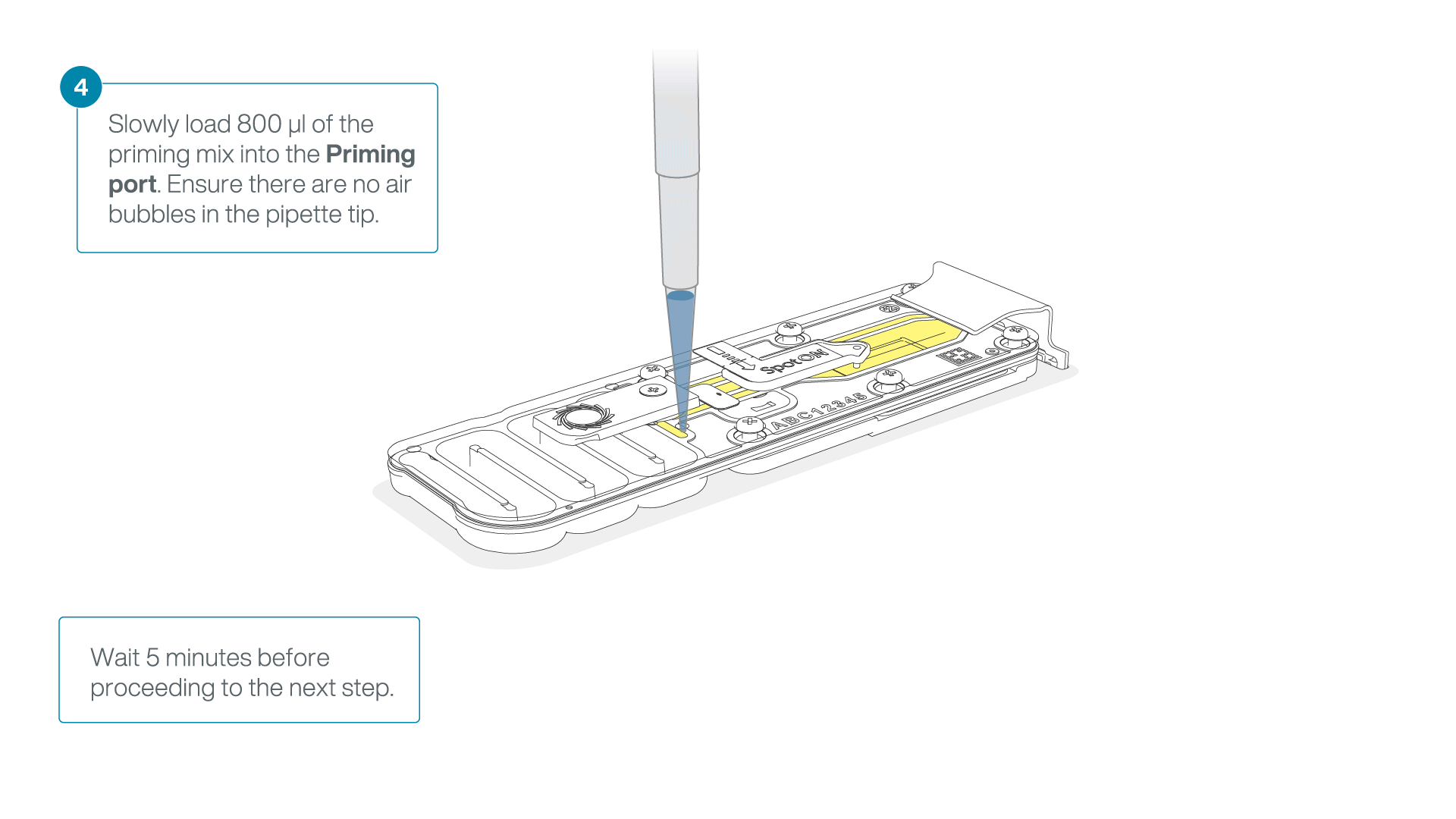
-
Thoroughly mix the contents of the Library Beads (LIB) by pipetting.
-
In a new 1.5 ml Eppendorf DNA LoBind tube, prepare the library for loading as follows:
Reagent Volume per flow cell Sequencing Buffer (SB) 37.5 µl Library Beads (LIB) mixed immediately before use, or Library Solution (LIS), if using 25.5 µl DNA library 12 µl Total 75 µl -
Complete the flow cell priming:
- Gently lift the SpotON sample port cover to make the SpotON sample port accessible.
- Load 200 µl of the priming mix into the flow cell priming port (not the SpotON sample port), avoiding the introduction of air bubbles.
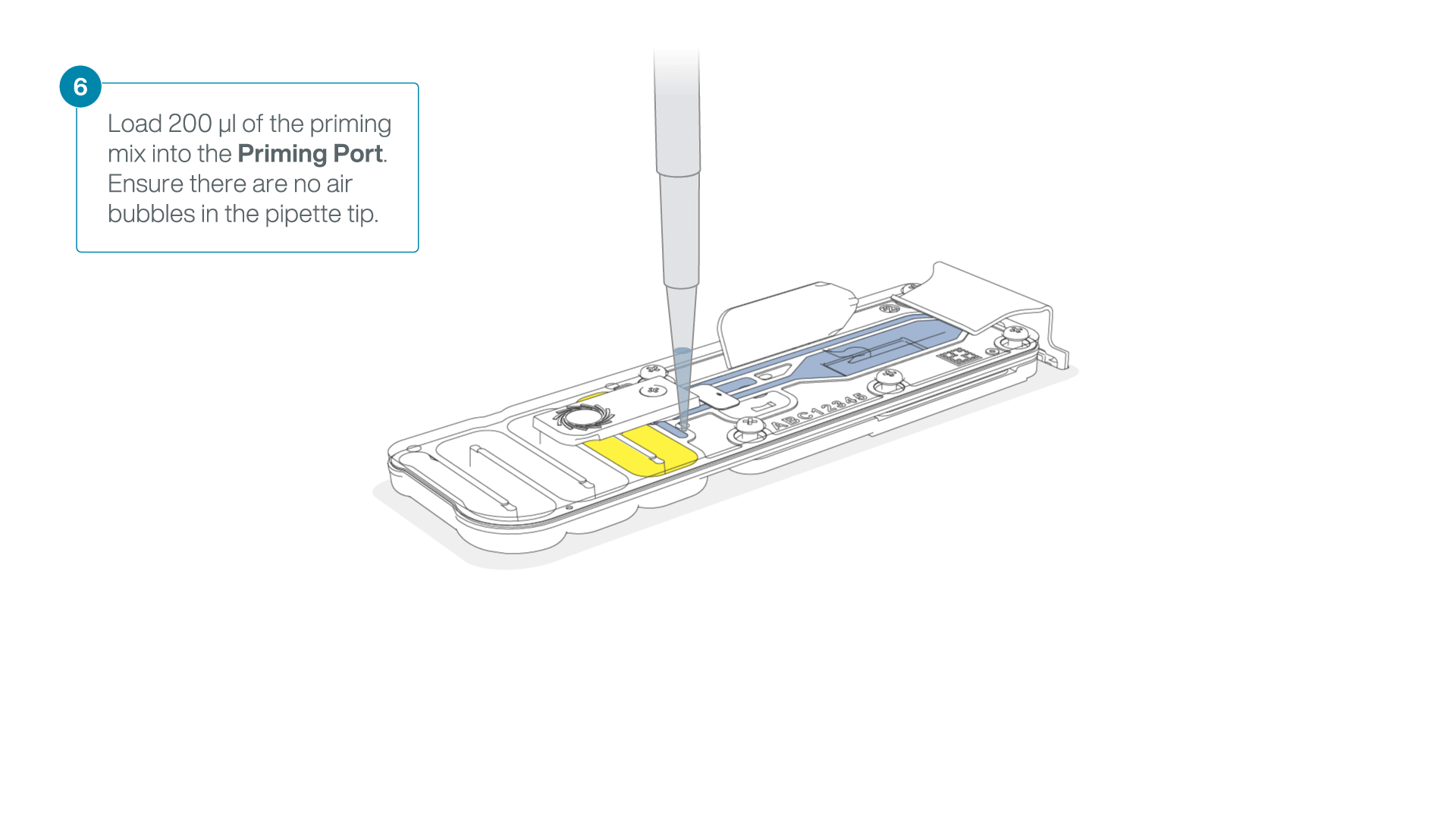
-
Mix the prepared library gently by pipetting up and down just prior to loading.
-
Add 75 μl of the prepared library to the flow cell via the SpotON sample port in a dropwise fashion. Ensure each drop flows into the port before adding the next.

-
Gently replace the SpotON sample port cover, making sure the bung enters the SpotON port and close the priming port.

-
Place the light shield onto the flow cell, as follows:
Carefully place the leading edge of the light shield against the clip.
Note: Do not force the light shield underneath the clip.Gently lower the light shield onto the flow cell. The light shield should sit around the SpotON cover, covering the entire top section of the flow cell.
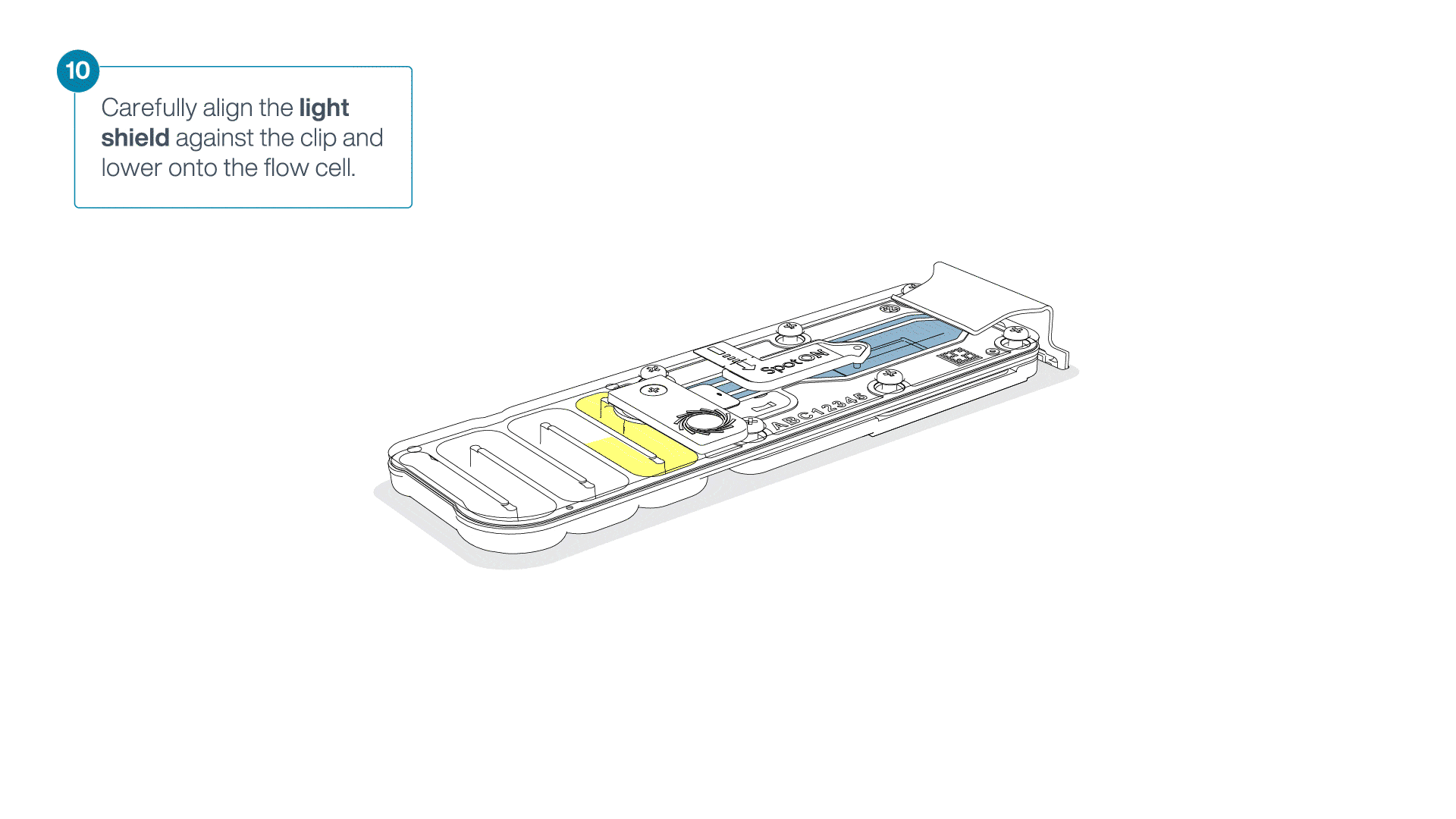
Sequencing and data analysis
Data acquisition and basecalling
Data acquisition and basecalling
-
How to start sequencing
The sequencing device control, data acquisition and real-time basecalling are carried out by the MinKNOW software. Please ensure MinKNOW is installed on your computer or device. Further instructions for setting up a sequencing run can be found in the MinKNOW protocol.
We recommend setting up a sequencing run on a MinION or GridION device using the basecalling and barcoding recommendations outlined below. All other parameters can be left to their default settings.
-
Open the MinKNOW software using the desktop shortcut and log into the MinKNOW software using your Community credentials.
-
Click on your connected device.

-
Set up a sequencing run by clicking Start sequencing.
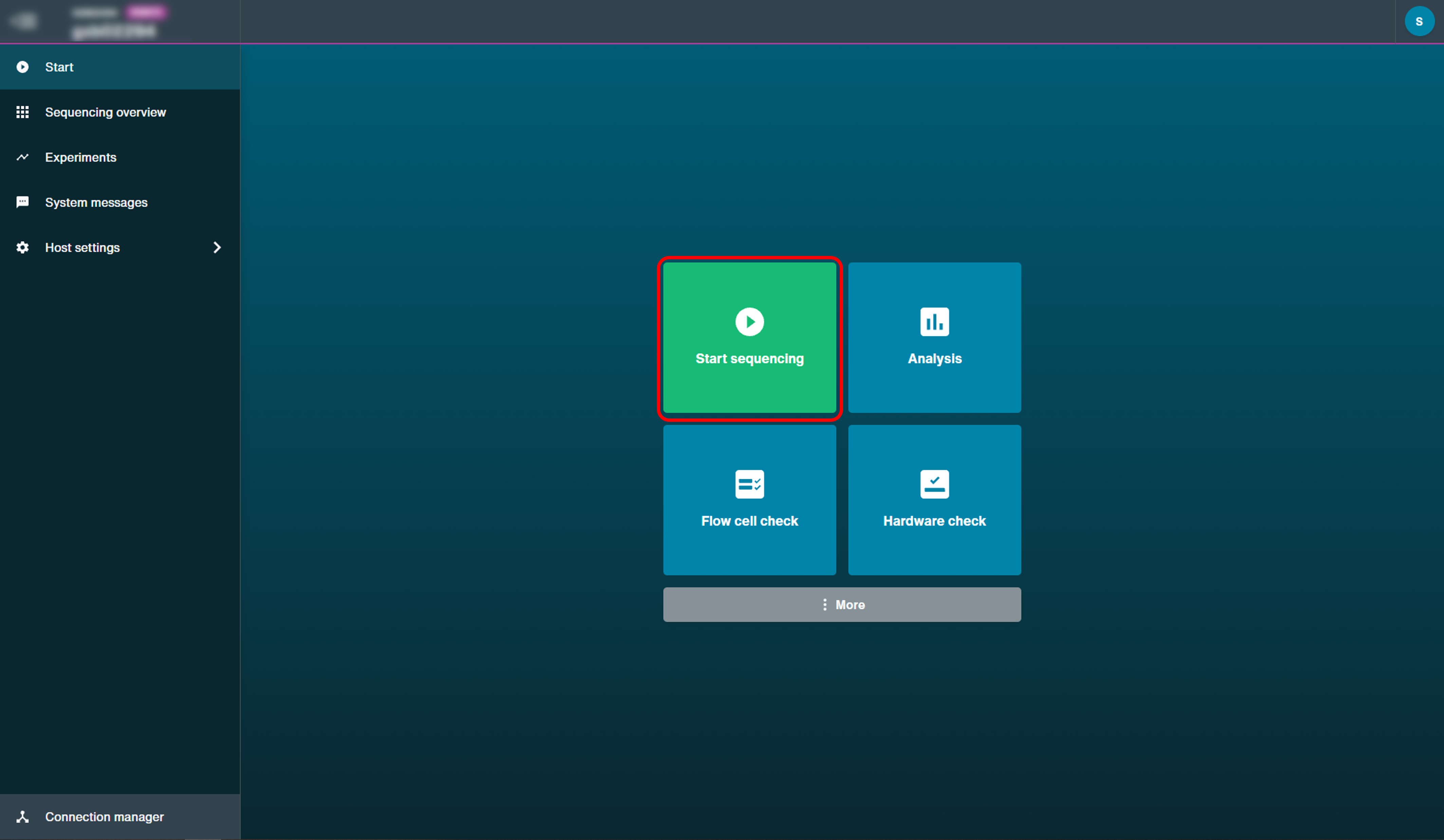
-
Select the Rapid Barcoding Kit 24 V14 (SQK-RBK114.24) or Rapid Barcoding Kit 96 V14 (SQK-RBK114.96)
Click Continue to Run Options to continue.
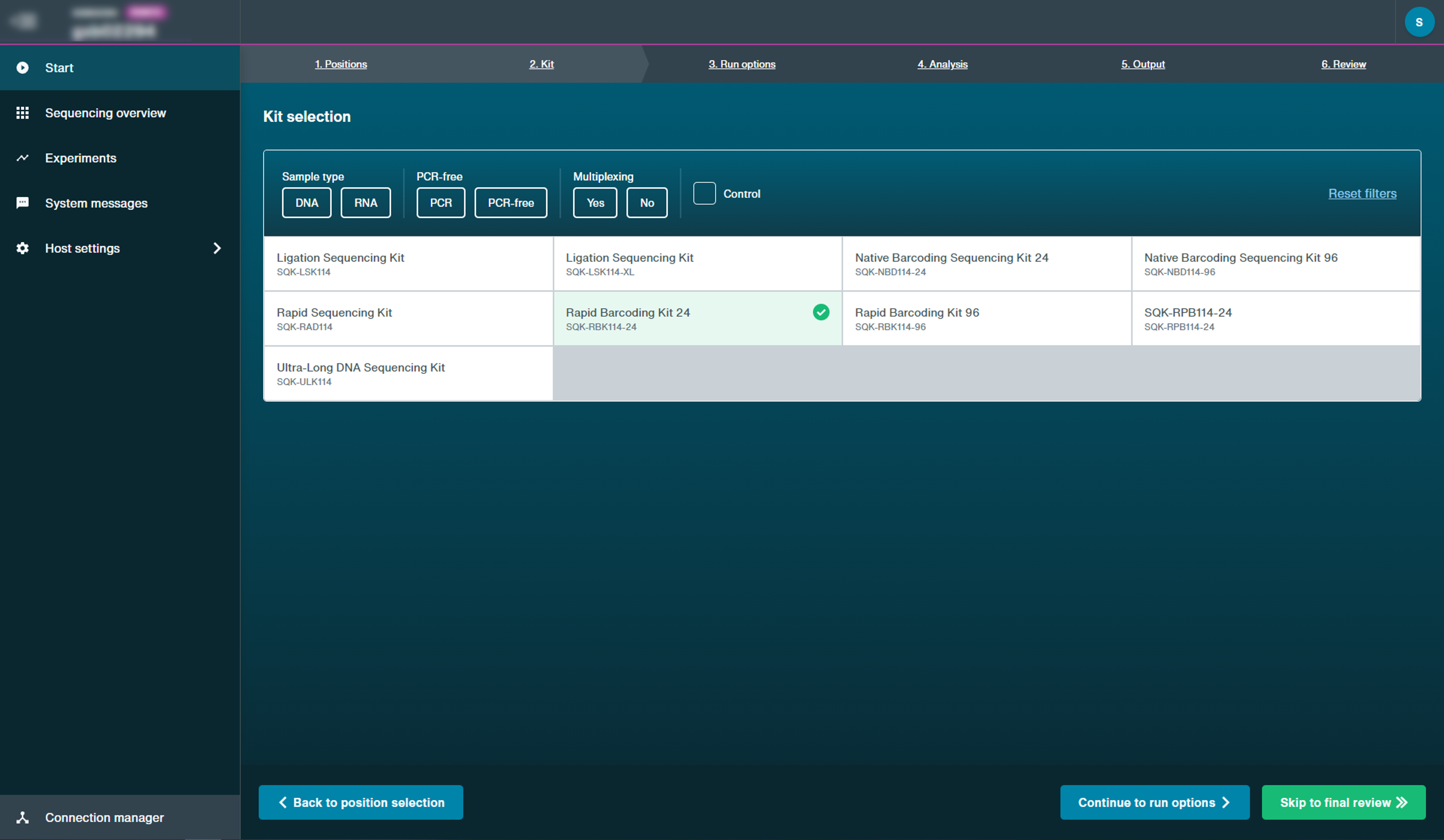
-
Keep the run options to their default settings of 72 hour run length and 200 bp minimum read length.
Click Continue to basecalling to continue.
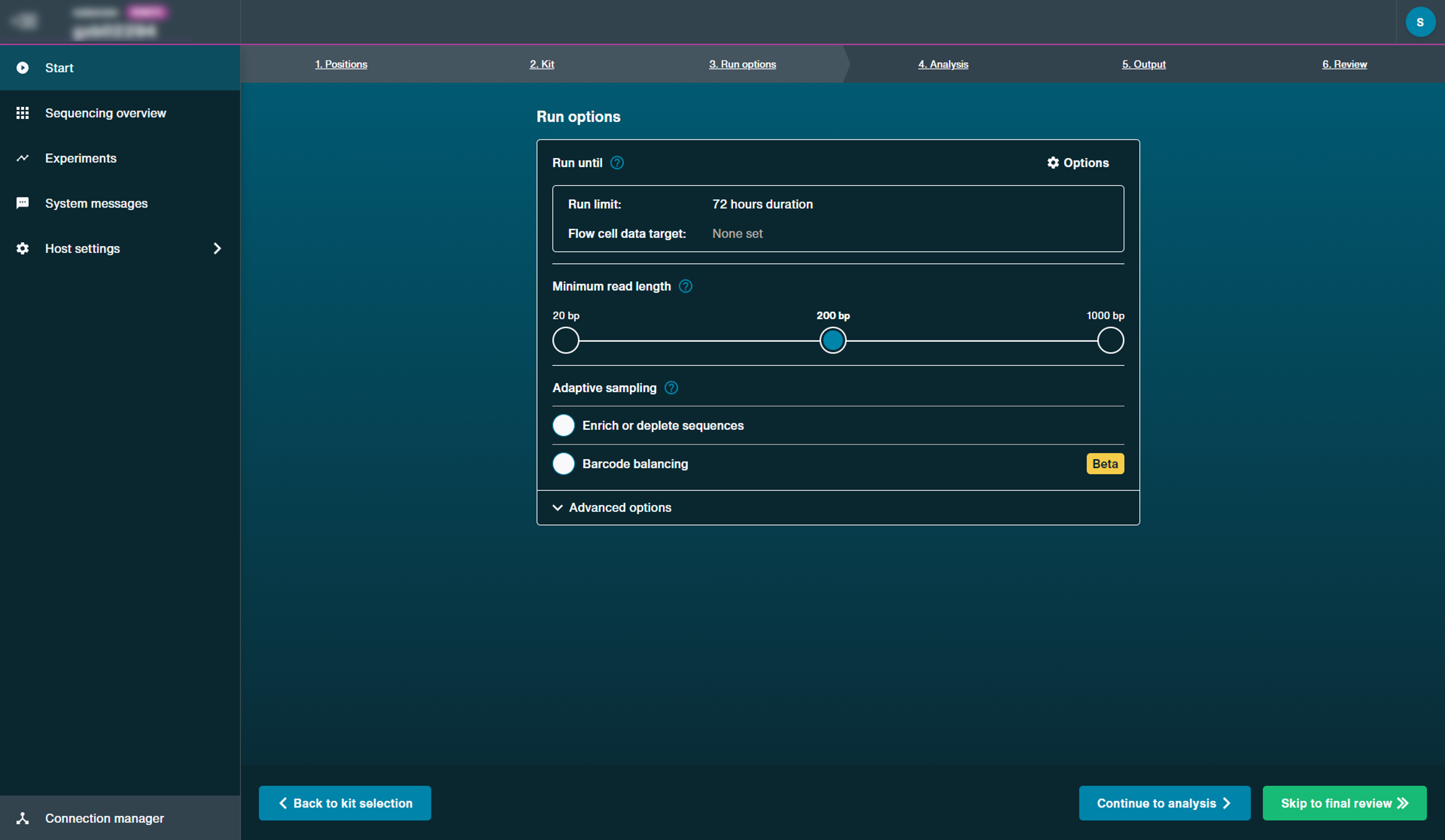
-
Set up basecalling and barcoding using the following parameters:
Ensure basecalling is ON.
Next to "Models", click Edit options and choose High accuracy basecaller (HAC) from the drop-down menu.
Ensure barcoding in ON.
Click Continue to output and continue.
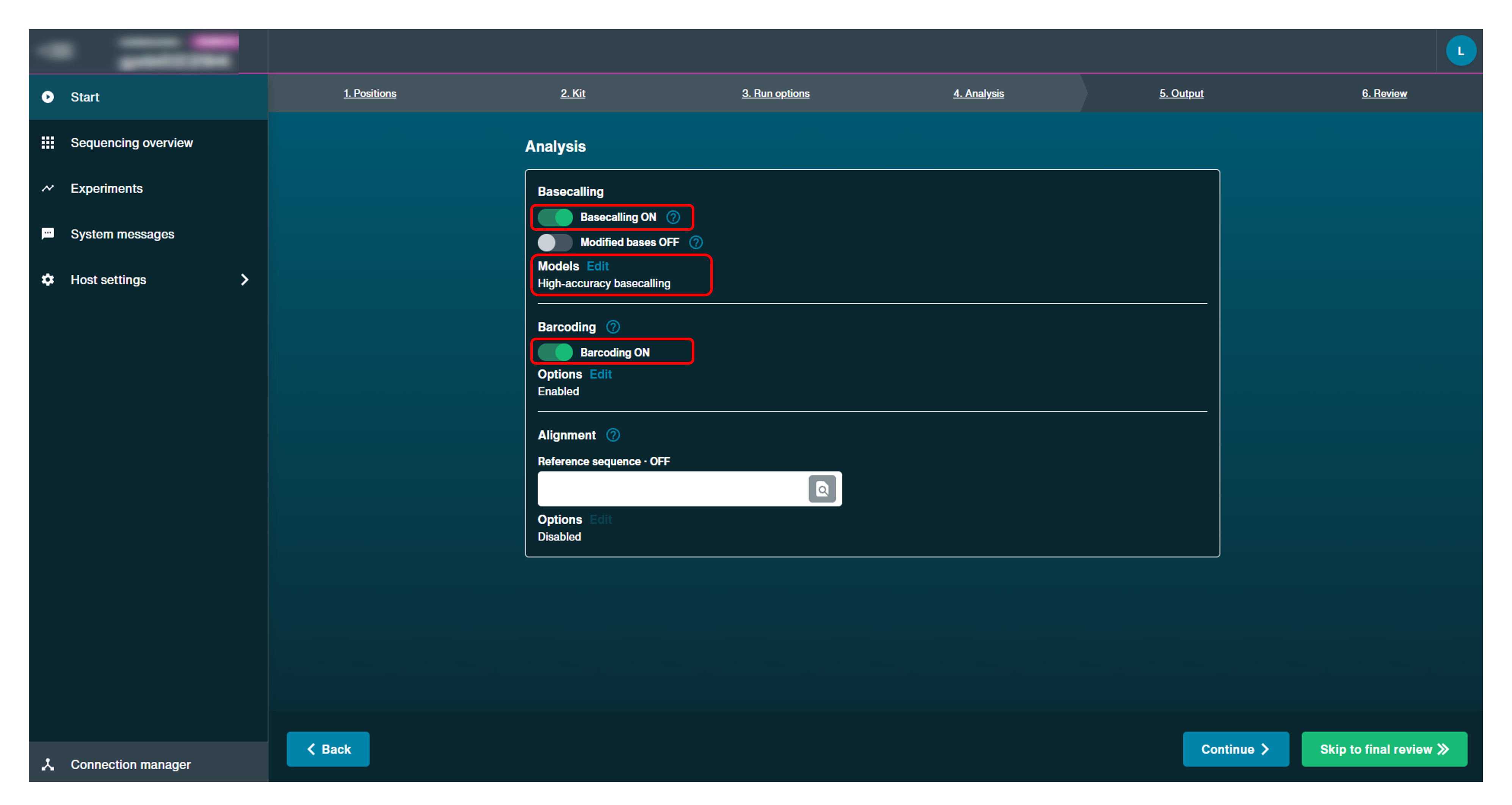
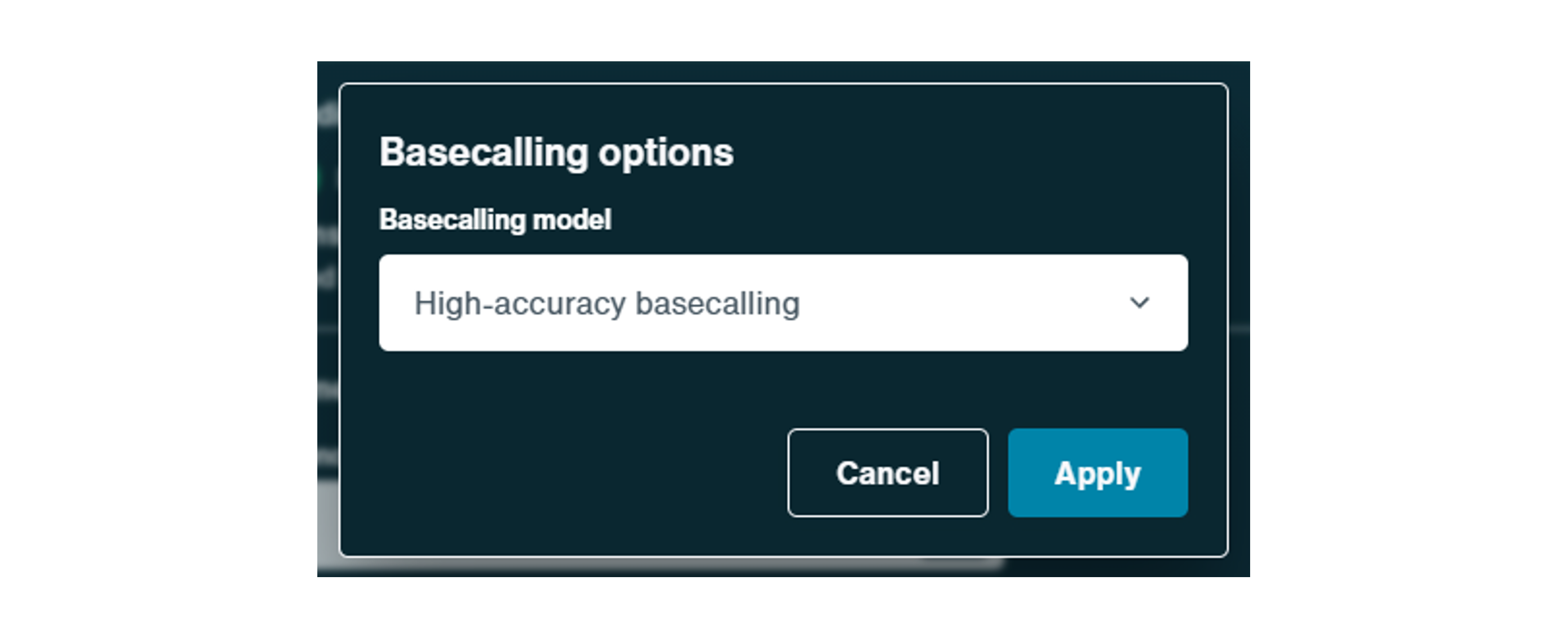
-
Set up the output format and filtering as follows:
Ensure .POD5 is seleceted as the Raw reads output format.
Ensure .FASTQ is selected for basecalled reads.
Ensure filtering is ON.
Click Continue to final review to continue.
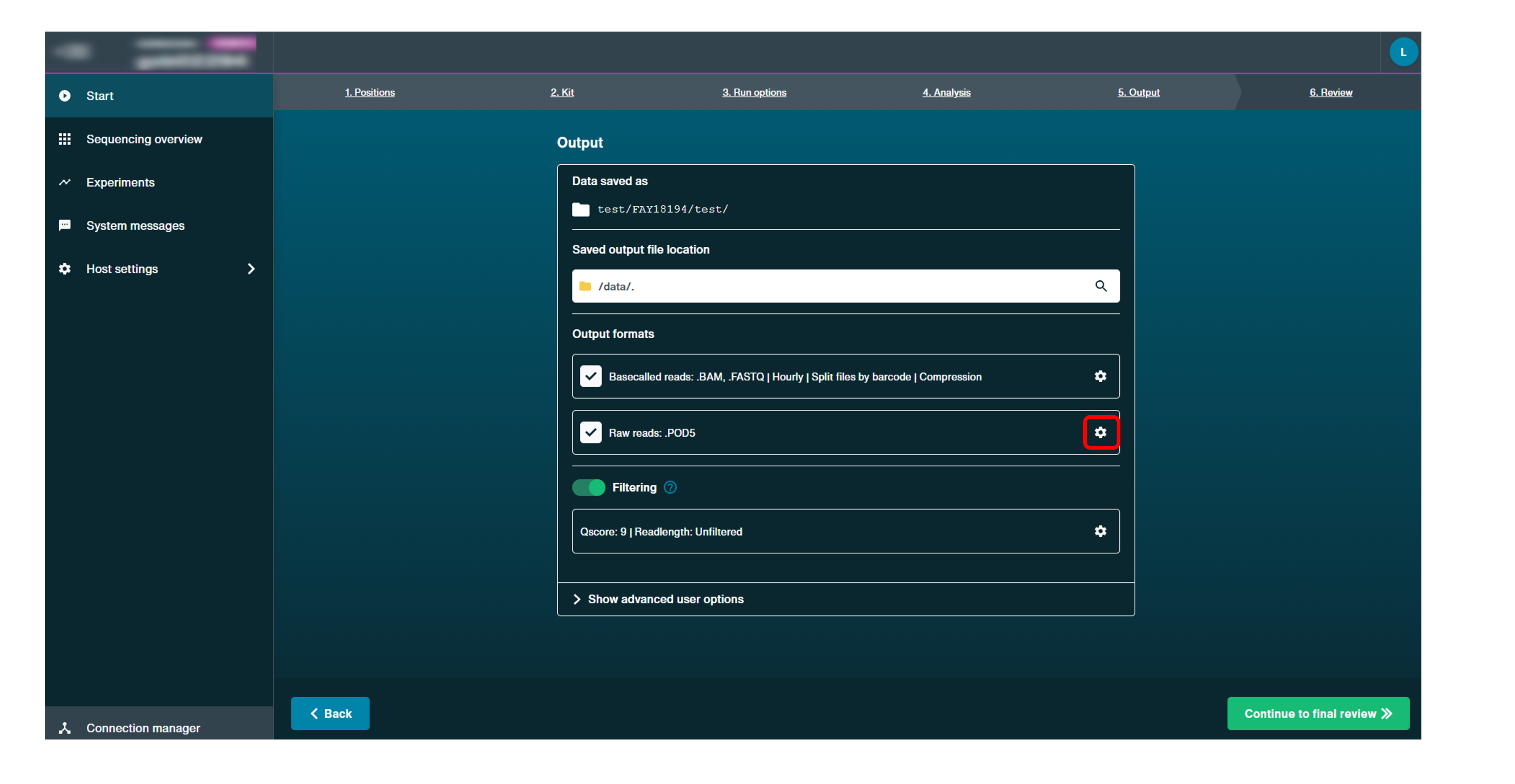
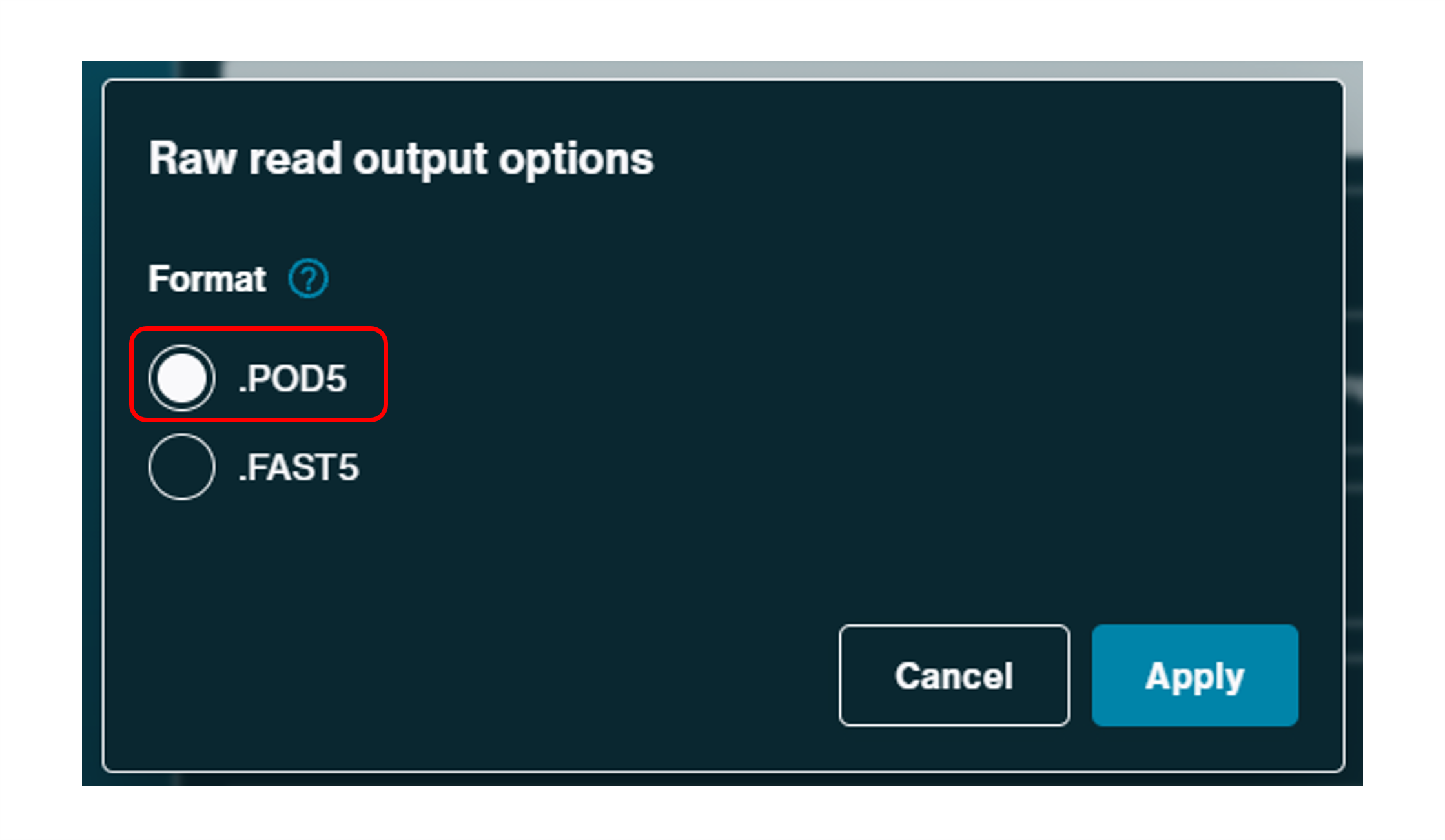
-
Click "Start" to start sequencing.
You will be automatically navigated to the "Sequencing Overview" page to monitor the sequencing run.
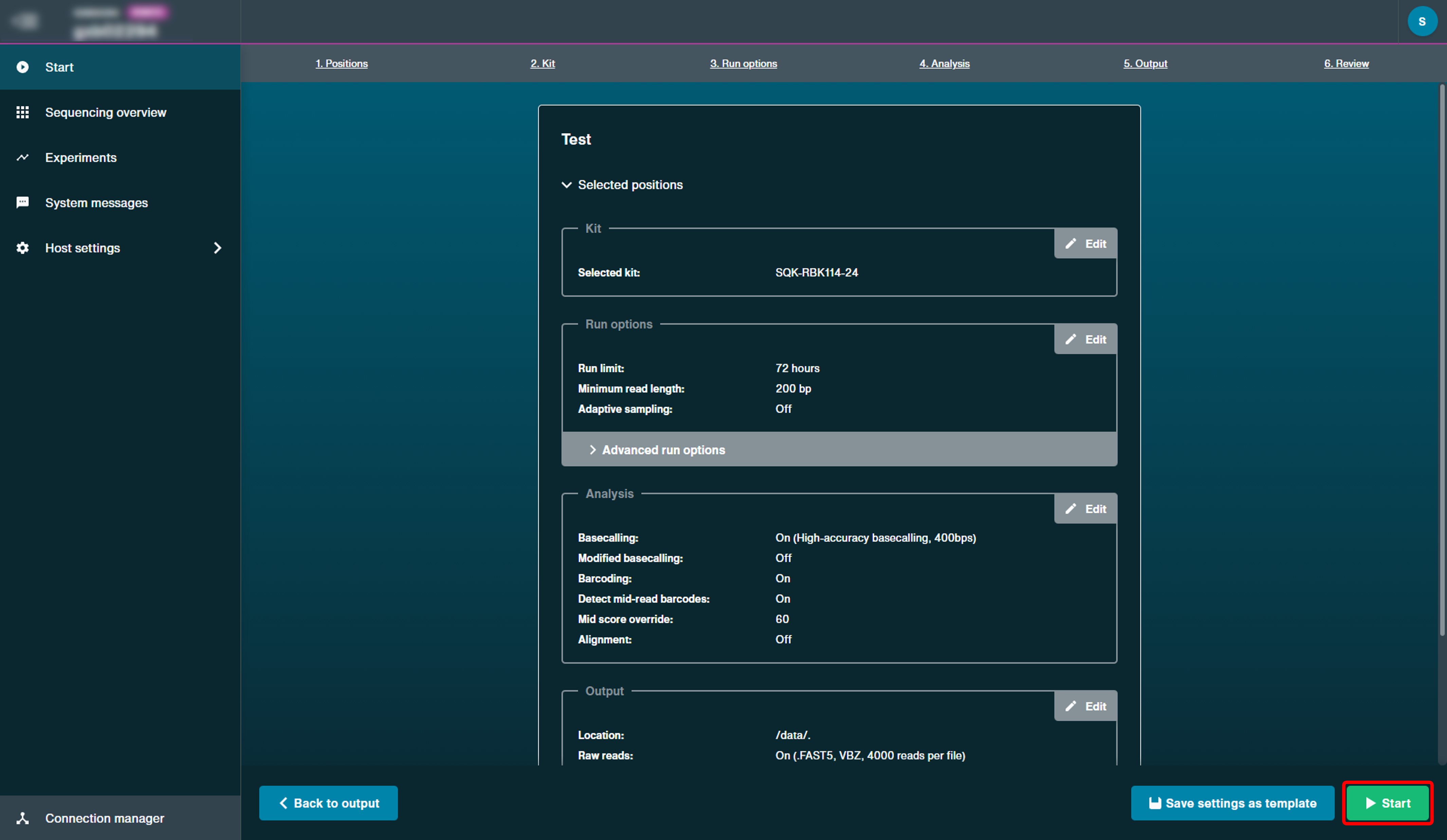
Downstream analysis
Downstream analysis
-
Post-basecalling analysis
We recommend performing downstream analysis using EPI2ME which facilitates bioinformatic analyses by allowing users to run Nextflow workflows in a desktop application. EPI2ME maintains a collection of bioinformatic workflows which are curated and actively maintained by experts in long-read sequence analysis.
Further information about the available EPI2ME workflows are available here, along with the Quick Start Guide to start your first bioinformatic workflow.
For the accurate and reliable assembly or alignment of bacterial or fungal isolate genomes generated from the included protocols, we recommend using the wf-bacterial-genomes workflow. At its core, the workflow is an efficient assembly pipeline which also polishes genomes using Medaka.
Whilst running the workflow using the default parameters will produce high quality genome assemblies, using the ‘Isolates’ mode will perform additional analyses designed to increase genome quality and aid genome interrogation for common pathogens in the clinical and food safety fields. ‘Isolates’ analyses includes MLST(7-gene), species confirmation and AMR prediction in addition to sample-specific reports.
Note: You can also run this workflow through command line. However, we only recommend this option for experienced users. For more information, please visit the wf-bacterial-genomes page on GitHub.
-
Open the EPI2ME app using the desktop shortcut.
-
Click install.
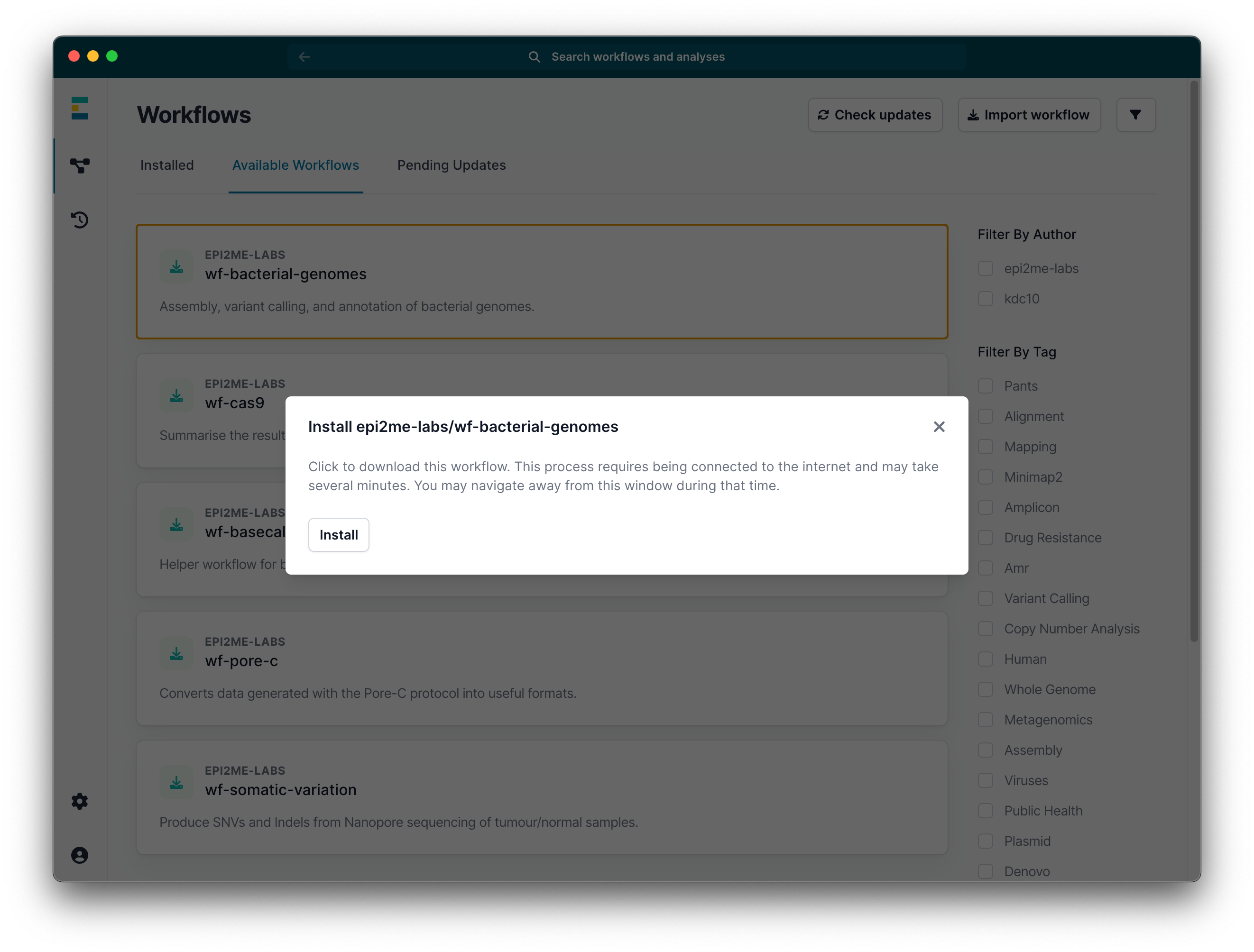
-
Optional ActionIf the workflow was already installed, check for updates by clicking 'Update workflow'.
Ensure you are using v1.3.0 or newer of the workflow. We recommend running the latest version of our workflows for the best results.
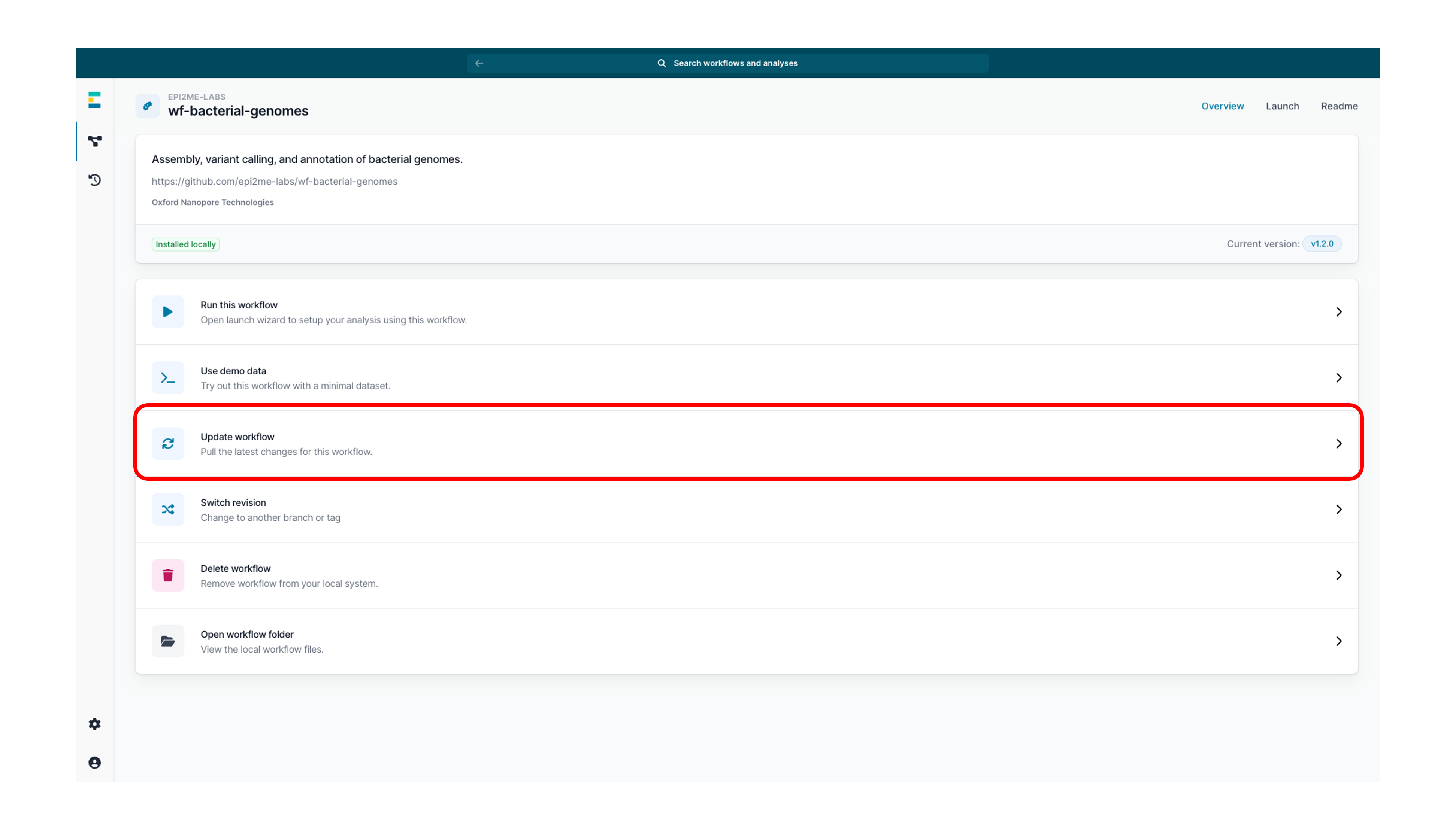
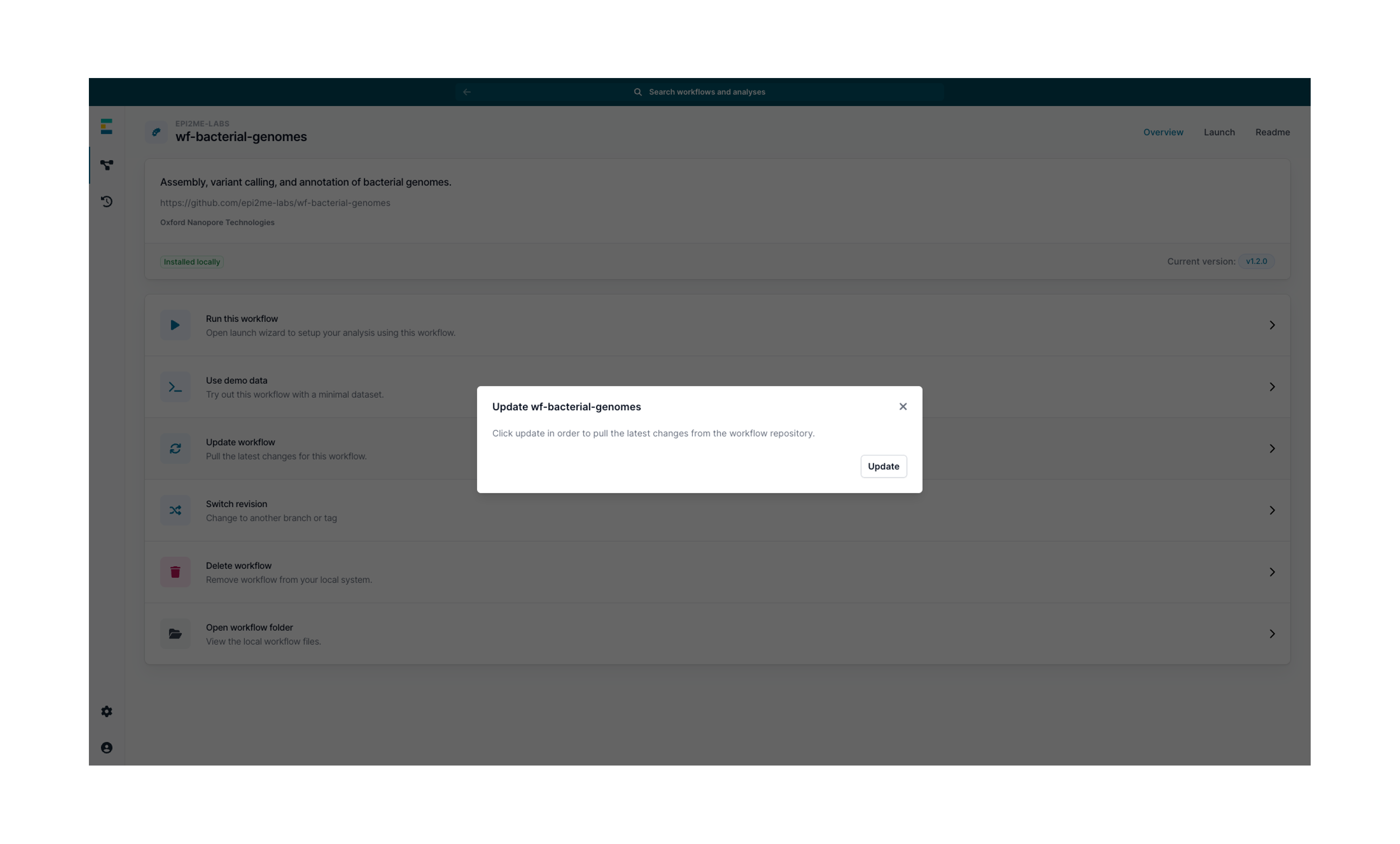
-
Click on Run this workflow to open the launch wizard.
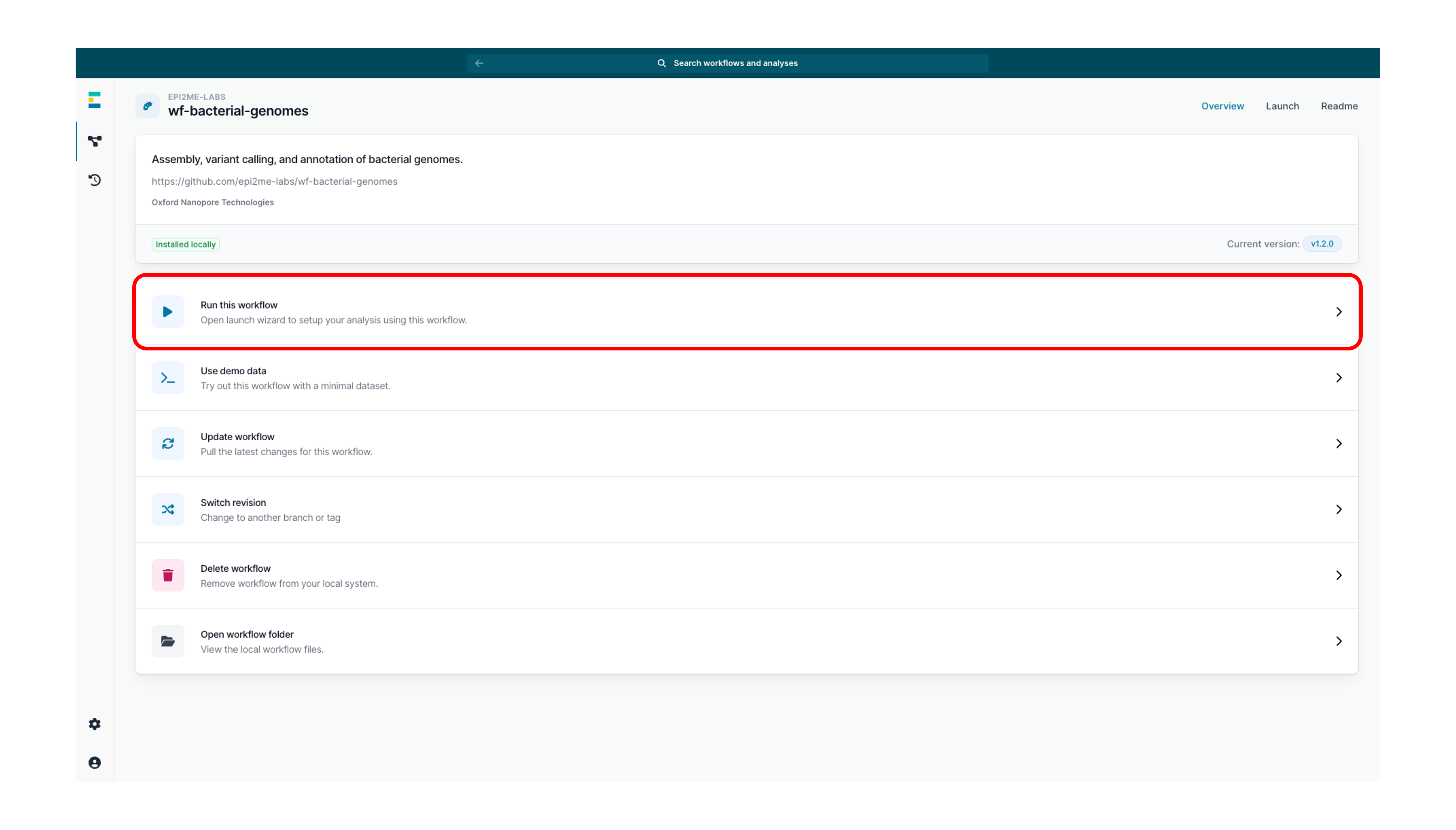
-
Set up your run by uploading your FASTQ file in the Input Options. We recommend keeping the default settings for the other parameter options.
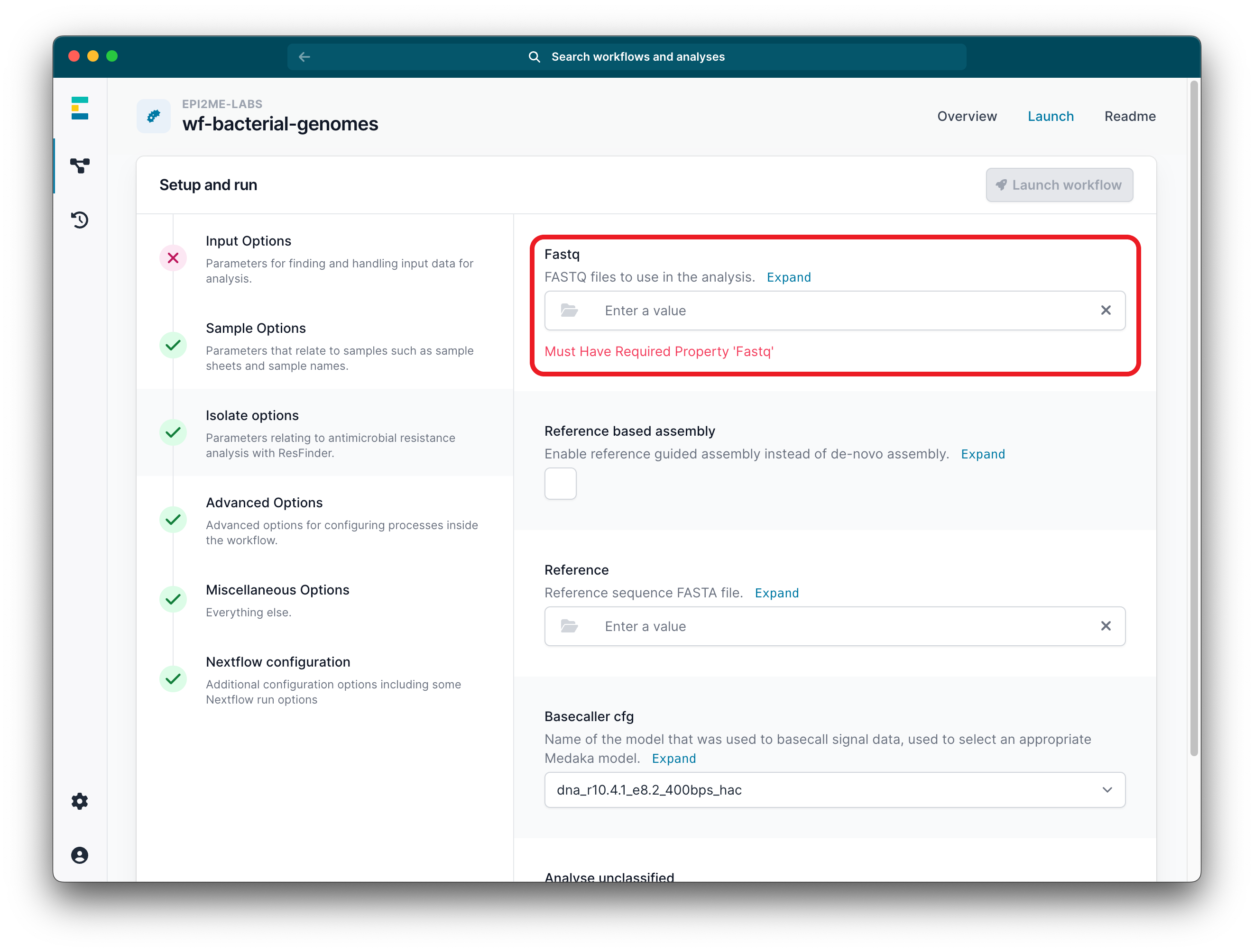
-
To enable the isolates mode, tick the isolates checkbox.
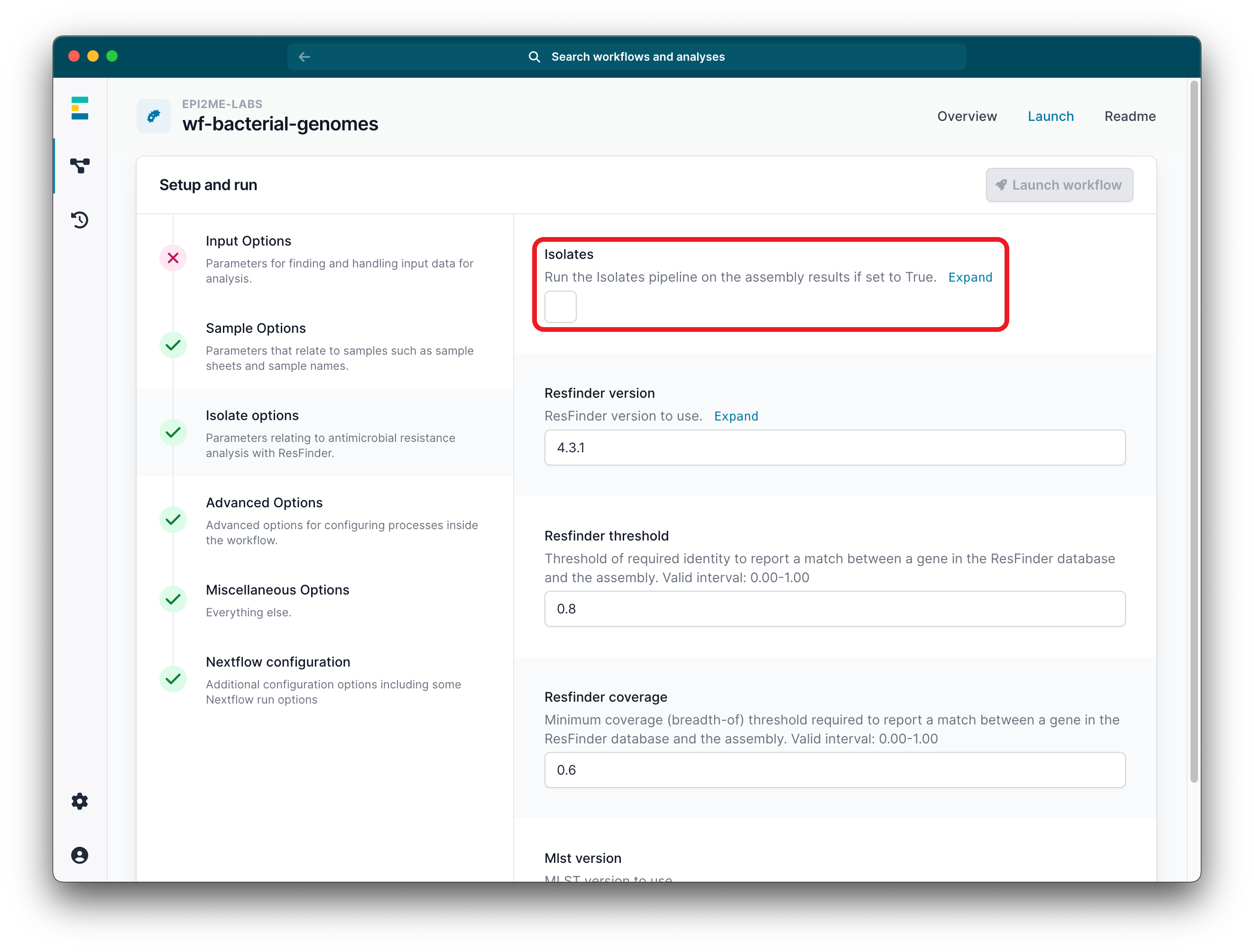
-
Click Launch workflow.
Ensure all parameter options have green ticks.
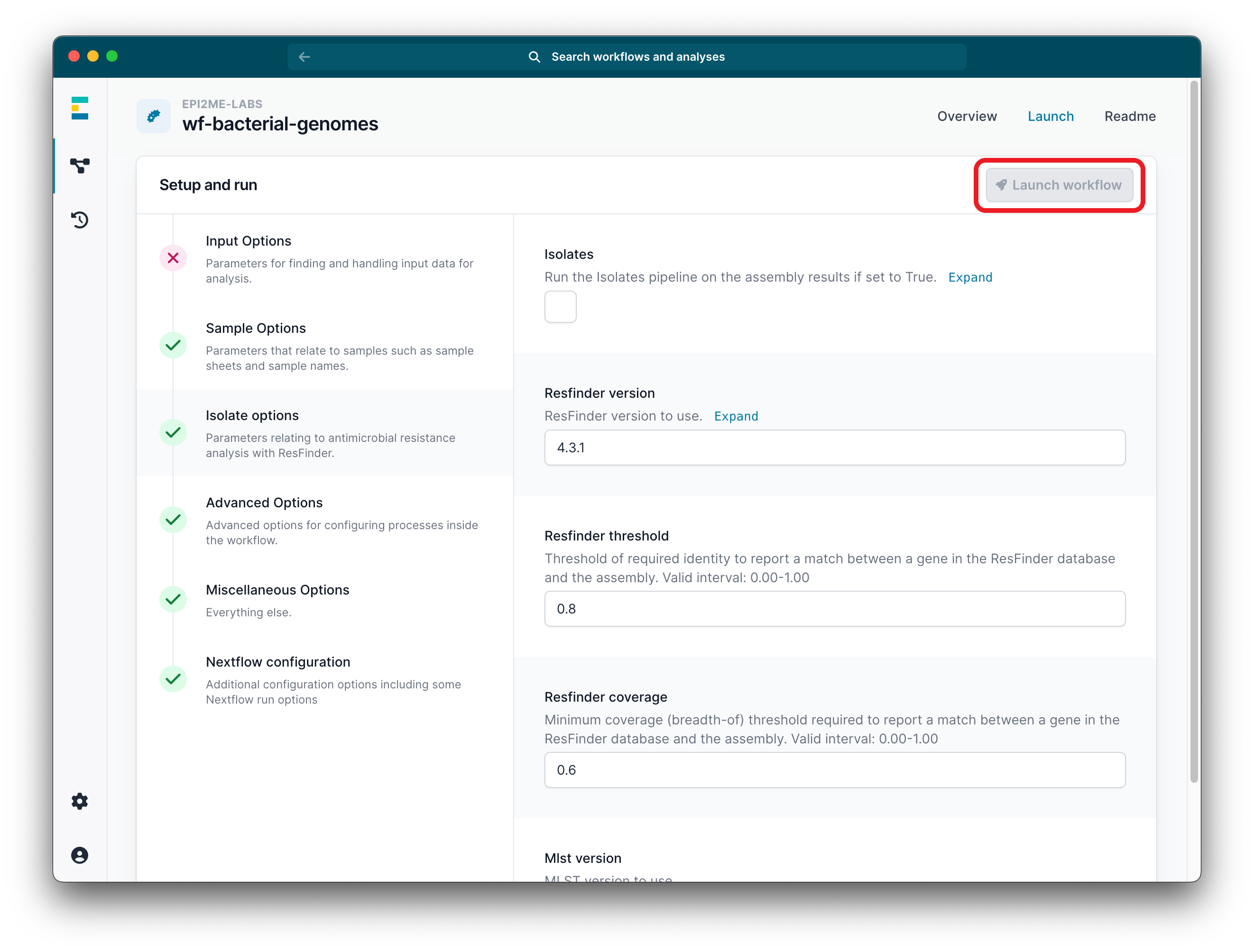
-
Once the workflow finishes, a report will be produced.
Flow cell reuse and returns
Flow cell reuse and returns
- Materials
-
- Flow Cell Wash Kit (EXP-WSH004)
-
After your sequencing experiment is complete, if you would like to reuse the flow cell, please follow the Flow Cell Wash Kit protocol and store the washed flow cell at +2°C to +8°C.
The Flow Cell Wash Kit protocol is available on the Nanopore Community.
-
Alternatively, follow the returns procedure to send the flow cell back to Oxford Nanopore.
Instructions for returning flow cells can be found here.
Troubleshooting
Issues during DNA extraction and library preparation
Issues during DNA extraction and library preparation
-
Below is a list of the most commonly encountered issues, with some suggested causes and solutions.
We also have an FAQ section available on the Nanopore Community Support section.
If you have tried our suggested solutions and the issue still persists, please contact Technical Support via email (support@nanoporetech.com) or via LiveChat in the Nanopore Community.
-
Low sample quality
Observation Possible cause Comments and actions Inefficient lysis Enzyme activity has degraded in the solution or the isolate species is hard to lyse. - Make a fresh enzyme solution.
- Follow the hard to lyse gDNA extraction method.
- Increase the enzyme incubation for longer than 10 minutes.Low DNA concentration Low input into the extraction method - Check the cell input used
- Add more input and perform the extraction again
- Elute in less Elution Buffer
- Concentrate the DNA with a 0.4X AMPure XP Bead wash.Low DNA integrity number (DIN) Low quality or concentration of sample input - Repeat the extraction with freshly made enzyme solution
- Concentrate the DNA input with a 0.4X washLow sequencing yield Low sample concentration - Concentrate the DNA with a 0.4X AMPure XP wash step to remove potential inhibitors.
- Check the DNA concentration and quality. RNA presence may affect quantification of total DNA.Low DNA purity (Nanodrop reading for DNA OD 260/280 is <1.8 and OD 260/230 is <2.0–2.2) The DNA extraction method does not provide the required purity The effects of contaminants are shown in the Contaminants Know-how piece. Please try an alternative extraction method that does not result in contaminant carryover.
Consider performing an additional SPRI clean-up step. -
Low DNA recovery after AMPure bead clean-up
Observation Possible cause Comments and actions Low recovery DNA loss due to a lower than intended AMPure beads-to-sample ratio 1. AMPure beads settle quickly, so ensure they are well resuspended before adding them to the sample.
2. When the AMPure beads-to-sample ratio is lower than 0.4:1, DNA fragments of any size will be lost during the clean-up.Low recovery DNA fragments are shorter than expected The lower the AMPure beads-to-sample ratio, the more stringent the selection against short fragments. Please always determine the input DNA length on an agarose gel (or other gel electrophoresis methods) and then calculate the appropriate amount of AMPure beads to use. 
Low recovery after end-prep The wash step used ethanol <70% DNA will be eluted from the beads when using ethanol <70%. Make sure to use the correct percentage.
Issues during the sequencing run using a Rapid-based sequencing kit
Issues during the sequencing run using a Rapid-based sequencing kit
-
Below is a list of the most commonly encountered issues, with some suggested causes and solutions.
We also have an FAQ section available on the Nanopore Community Support section.
If you have tried our suggested solutions and the issue still persists, please contact Technical Support via email (support@nanoporetech.com) or via LiveChat in the Nanopore Community.
-
Fewer pores at the start of sequencing than after Flow Cell Check
Observation Possible cause Comments and actions MinKNOW reported a lower number of pores at the start of sequencing than the number reported by the Flow Cell Check An air bubble was introduced into the nanopore array After the Flow Cell Check it is essential to remove any air bubbles near the priming port before priming the flow cell. If not removed, the air bubble can travel to the nanopore array and irreversibly damage the nanopores that have been exposed to air. The best practice to prevent this from happening is demonstrated in this video. MinKNOW reported a lower number of pores at the start of sequencing than the number reported by the Flow Cell Check The flow cell is not correctly inserted into the device Stop the sequencing run, remove the flow cell from the sequencing device and insert it again, checking that the flow cell is firmly seated in the device and that it has reached the target temperature. If applicable, try a different position on the device (GridION/PromethION). MinKNOW reported a lower number of pores at the start of sequencing than the number reported by the Flow Cell Check Contaminations in the library damaged or blocked the pores The pore count during the Flow Cell Check is performed using the QC DNA molecules present in the flow cell storage buffer. At the start of sequencing, the library itself is used to estimate the number of active pores. Because of this, variability of about 10% in the number of pores is expected. A significantly lower pore count reported at the start of sequencing can be due to contaminants in the library that have damaged the membranes or blocked the pores. Alternative DNA/RNA extraction or purification methods may be needed to improve the purity of the input material. The effects of contaminants are shown in the Contaminants Know-how piece. Please try an alternative extraction method that does not result in contaminant carryover. -
MinKNOW script failed
Observation Possible cause Comments and actions MinKNOW shows "Script failed" Restart the computer and then restart MinKNOW. If the issue persists, please collect the MinKNOW log files and contact Technical Support. If you do not have another sequencing device available, we recommend storing the flow cell and the loaded library at 4°C and contact Technical Support for further storage guidance. -
Pore occupancy below 40%
Observation Possible cause Comments and actions Pore occupancy <40% Not enough library was loaded on the flow cell Ensure the correct concentration of good quality library is loaded on to a MinION/GridION flow cell. To check the concentration, please refer to the library preparation protocol. Please quantify the library before loading and calculate mols using tools like the Promega Biomath Calculator, choosing "dsDNA: µg to pmol" Pore occupancy close to 0 The Rapid Sequencing Kit V14/Rapid Barcoding Kit V14 was used, and sequencing adapters did not attach to the DNA Make sure to closely follow the protocol and use the correct volumes and incubation temperatures. A Lambda control library can be prepared to test the integrity of reagents. Pore occupancy close to 0 No tether on the flow cell Tethers are adding during flow cell priming (FCT tube). Make sure FCT was added to FCF before priming. -
Shorter than expected read length
Observation Possible cause Comments and actions Shorter than expected read length Unwanted fragmentation of DNA sample Read length reflects input DNA fragment length. Input DNA can be fragmented during extraction and library prep.
1. Please review the Extraction Methods in the Nanopore Community for best practice for extraction.
2. Visualise the input DNA fragment length distribution on an agarose gel before proceeding to the library prep.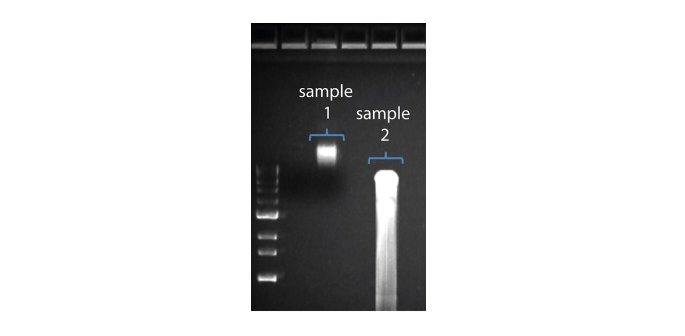 In the image above, Sample 1 is of high molecular weight, whereas Sample 2 has been fragmented.
In the image above, Sample 1 is of high molecular weight, whereas Sample 2 has been fragmented.
3. During library prep, avoid pipetting and vortexing when mixing reagents. Flicking or inverting the tube is sufficient. -
Large proportion of inactive pores
Observation Possible cause Comments and actions Large proportion of inactive/unavailable pores (shown as light blue in the channels panel and pore activity plot. Pores or membranes are irreversibly damaged) Air bubbles have been introduced into the flow cell Air bubbles introduced through flow cell priming and library loading can irreversibly damage the pores. Watch the Priming and loading your flow cell video for best practice Large proportion of inactive/unavailable pores Certain compounds co-purified with DNA Known compounds, include polysaccharides, typically associate with plant genomic DNA.
1. Please refer to the Plant leaf DNA extraction method.
2. Clean-up using the QIAGEN PowerClean Pro kit.
3. Perform a whole genome amplification with the original gDNA sample using the QIAGEN REPLI-g kit.Large proportion of inactive/unavailable pores Contaminants are present in the sample The effects of contaminants are shown in the Contaminants Know-how piece. Please try an alternative extraction method that does not result in contaminant carryover. -
Temperature fluctuation
Observation Possible cause Comments and actions Temperature fluctuation The flow cell has lost contact with the device Check that there is a heat pad covering the metal plate on the back of the flow cell. Re-insert the flow cell and press it down to make sure the connector pins are firmly in contact with the device. If the problem persists, please contact Technical Services. -
Failed to reach target temperature
Observation Possible cause Comments and actions MinKNOW shows "Failed to reach target temperature" The instrument was placed in a location that is colder than normal room temperature, or a location with poor ventilation (which leads to the flow cells overheating) MinKNOW has a default timeframe for the flow cell to reach the target temperature. Once the timeframe is exceeded, an error message will appear and the sequencing experiment will continue. However, sequencing at an incorrect temperature may lead to a decrease in throughput and lower q-scores. Please adjust the location of the sequencing device to ensure that it is placed at room temperature with good ventilation, then re-start the process in MinKNOW. Please refer to this link for more information on MinION temperature control.
Become a full member
Purchase a MinION Starter Pack from Avantor to get full community access and benefit from:
- News - hear about the latest product updates
- Posts - interact with thousands of nanopore users from around the globe
- Software - download the latest sequencing and analysis software
Already have a Nanopore Community account?
Log in hereNeed more help?
Request a call with our experts for detailed advice on implementing nanopore sequencing.
Request a callInterested in microbiology?
Visit our microbial sequencing spotlight page on vwr.com.
Microbial sequencing





























 In the image above, Sample 1 is of high molecular weight, whereas Sample 2 has been fragmented.
In the image above, Sample 1 is of high molecular weight, whereas Sample 2 has been fragmented. The pore activity plot above shows an increasing proportion of "unavailable" pores over time.
The pore activity plot above shows an increasing proportion of "unavailable" pores over time.